Marvell Semiconductor MMC85PG MC85 Mini Card 11b/g/a/n Radio Card User Manual
Marvell Semiconductor, Inc. MC85 Mini Card 11b/g/a/n Radio Card
Contents
- 1. User manual Host
- 2. user manual host
User manual Host

HARDWARE REFERENCE
Gateway Notebook

i
Chapter 1: About this reference. . . . . . . . . . . . . . . . . . . . . . . . . . . . . . . . . . . . . . . . . . . . . . .1
About this guide . . . . . . . . . . . . . . . . . . . . . . . . . . . . . . . . . . . . . . . . . . . . . . . . . . . . . . . . 2
Accessing the online User Guide . . . . . . . . . . . . . . . . . . . . . . . . . . . . . . . . . . . . . . . . . 2
Gateway contact information . . . . . . . . . . . . . . . . . . . . . . . . . . . . . . . . . . . . . . . . . . . . 2
Gateway model and serial number . . . . . . . . . . . . . . . . . . . . . . . . . . . . . . . . . . . 2
Microsoft Certificate of Authenticity . . . . . . . . . . . . . . . . . . . . . . . . . . . . . . . . . . . . . 3
For more information . . . . . . . . . . . . . . . . . . . . . . . . . . . . . . . . . . . . . . . . . . . . . . . . . . . 3
Chapter 2: Checking Out Your Gateway Notebook . . . . . . . . . . . . . . . . . . . . . . . . . . . . .5
Identifying features . . . . . . . . . . . . . . . . . . . . . . . . . . . . . . . . . . . . . . . . . . . . . . . . . . . . . . 6
Front . . . . . . . . . . . . . . . . . . . . . . . . . . . . . . . . . . . . . . . . . . . . . . . . . . . . . . . . . . . . . . . . 6
Left . . . . . . . . . . . . . . . . . . . . . . . . . . . . . . . . . . . . . . . . . . . . . . . . . . . . . . . . . . . . . . . . . . 7
Right . . . . . . . . . . . . . . . . . . . . . . . . . . . . . . . . . . . . . . . . . . . . . . . . . . . . . . . . . . . . . . . . 7
Back . . . . . . . . . . . . . . . . . . . . . . . . . . . . . . . . . . . . . . . . . . . . . . . . . . . . . . . . . . . . . . . . . 8
Bottom . . . . . . . . . . . . . . . . . . . . . . . . . . . . . . . . . . . . . . . . . . . . . . . . . . . . . . . . . . . . . . 9
Keyboard area . . . . . . . . . . . . . . . . . . . . . . . . . . . . . . . . . . . . . . . . . . . . . . . . . . . . . . 10
Connecting the AC adapter . . . . . . . . . . . . . . . . . . . . . . . . . . . . . . . . . . . . . . . . . . . . . 11
Protecting from power source problems . . . . . . . . . . . . . . . . . . . . . . . . . . . . 12
Connecting the dial-up modem . . . . . . . . . . . . . . . . . . . . . . . . . . . . . . . . . . . . . . . . 12
Connecting to a cable or DSL modem or to an Ethernet network . . . . . . . . 13
Starting your notebook . . . . . . . . . . . . . . . . . . . . . . . . . . . . . . . . . . . . . . . . . . . . . . . . . 14
Waking up your notebook . . . . . . . . . . . . . . . . . . . . . . . . . . . . . . . . . . . . . . . . . . 14
Using CyberLink PowerCinema . . . . . . . . . . . . . . . . . . . . . . . . . . . . . . . . . . . . . . 14
Turning off your notebook . . . . . . . . . . . . . . . . . . . . . . . . . . . . . . . . . . . . . . . . . . . . . 15
Restarting (rebooting) your notebook . . . . . . . . . . . . . . . . . . . . . . . . . . . . . . . . . . 15
Using the status indicators . . . . . . . . . . . . . . . . . . . . . . . . . . . . . . . . . . . . . . . . . . . . . 16
Using the keyboard . . . . . . . . . . . . . . . . . . . . . . . . . . . . . . . . . . . . . . . . . . . . . . . . . . . . 17
Key types . . . . . . . . . . . . . . . . . . . . . . . . . . . . . . . . . . . . . . . . . . . . . . . . . . . . . . . . . . . 17
System key combinations . . . . . . . . . . . . . . . . . . . . . . . . . . . . . . . . . . . . . . . . . . . 18
Using the multimedia buttons . . . . . . . . . . . . . . . . . . . . . . . . . . . . . . . . . . . . . . . . . . 20
Using the EZ Pad touchpad . . . . . . . . . . . . . . . . . . . . . . . . . . . . . . . . . . . . . . . . . . . . . 21
Adjusting the volume . . . . . . . . . . . . . . . . . . . . . . . . . . . . . . . . . . . . . . . . . . . . . . . . . . 23
Turning your wireless radio on or off . . . . . . . . . . . . . . . . . . . . . . . . . . . . . . . . . . . 23
Using the CD or DVD drive . . . . . . . . . . . . . . . . . . . . . . . . . . . . . . . . . . . . . . . . . . . . . 24
Identifying drive types . . . . . . . . . . . . . . . . . . . . . . . . . . . . . . . . . . . . . . . . . . . . . . 24
Inserting a CD or DVD . . . . . . . . . . . . . . . . . . . . . . . . . . . . . . . . . . . . . . . . . . . . . . 25
Using the memory card reader . . . . . . . . . . . . . . . . . . . . . . . . . . . . . . . . . . . . . . . . . 25
Memory card types . . . . . . . . . . . . . . . . . . . . . . . . . . . . . . . . . . . . . . . . . . . . . . . . . 25
Inserting a memory card . . . . . . . . . . . . . . . . . . . . . . . . . . . . . . . . . . . . . . . . . . . . 25
Using a memory card . . . . . . . . . . . . . . . . . . . . . . . . . . . . . . . . . . . . . . . . . . . . . . . 26
Removing a memory card . . . . . . . . . . . . . . . . . . . . . . . . . . . . . . . . . . . . . . . . . . . 26
Inserting and removing an Express Card . . . . . . . . . . . . . . . . . . . . . . . . . . . . . . . . 27
Installing a printer, scanner, digital camera, or other peripheral device . . 28
Viewing the display on a projector or monitor . . . . . . . . . . . . . . . . . . . . . . . . . . 28
Contents
Contents www.gateway.com
ii
Viewing the display on a television . . . . . . . . . . . . . . . . . . . . . . . . . . . . . . . . . . . . . .30
Connecting a video camera to your notebook . . . . . . . . . . . . . . . . . . . . . . . . . . .31
Changing batteries . . . . . . . . . . . . . . . . . . . . . . . . . . . . . . . . . . . . . . . . . . . . . . . . . . . . .31
Replacing the battery . . . . . . . . . . . . . . . . . . . . . . . . . . . . . . . . . . . . . . . . . . . . . . .31
Recalibrating the battery . . . . . . . . . . . . . . . . . . . . . . . . . . . . . . . . . . . . . . . . . . . . . . . .32
Ordering accessories . . . . . . . . . . . . . . . . . . . . . . . . . . . . . . . . . . . . . . . . . . . . . . . . . . . .33
Chapter 3: Maintaining and Upgrading Your Notebook . . . . . . . . . . . . . . . . . . . . . . .35
Preventing static electricity discharge . . . . . . . . . . . . . . . . . . . . . . . . . . . . . . . . . . .36
Adding or replacing memory modules . . . . . . . . . . . . . . . . . . . . . . . . . . . . . . . . . .36
Replacing the CD or DVD drive . . . . . . . . . . . . . . . . . . . . . . . . . . . . . . . . . . . . . . . . . .40
Replacing the hard drive kit . . . . . . . . . . . . . . . . . . . . . . . . . . . . . . . . . . . . . . . . . . . . .42
Replacing the keyboard . . . . . . . . . . . . . . . . . . . . . . . . . . . . . . . . . . . . . . . . . . . . . . . . .45
Removing the keyboard . . . . . . . . . . . . . . . . . . . . . . . . . . . . . . . . . . . . . . . . . . . . .45
Installing the keyboard . . . . . . . . . . . . . . . . . . . . . . . . . . . . . . . . . . . . . . . . . . . . . .49
Appendix A: Safety, Regulatory, and Legal Information . . . . . . . . . . . . . . . . . . . . . . 51
Index . . . . . . . . . . . . . . . . . . . . . . . . . . . . . . . . . . . . . . . . . . . . . . . . . . . . . . . . . . . . . . . . . . . . . 63

CHAPTER 1
1
About this reference
•About this guide
• Accessing the online User Guide
• Gateway contact information
• Microsoft Certificate of Authenticity
•For more information
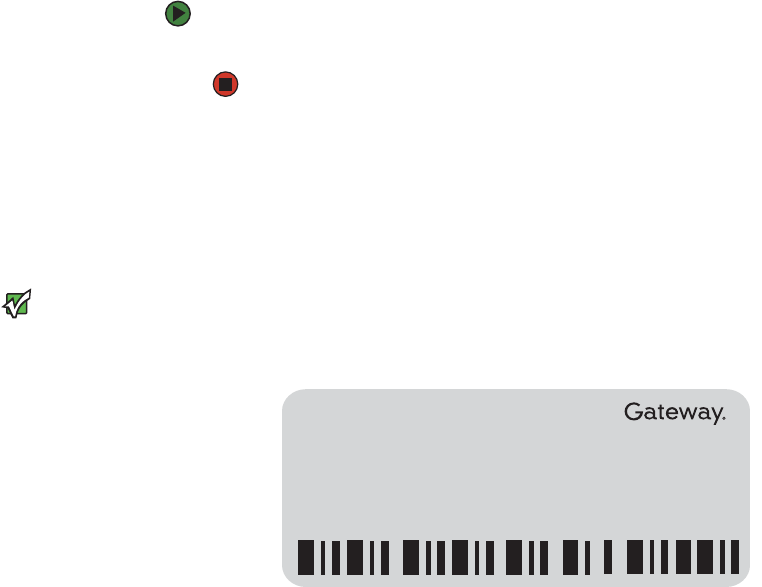
CHAPTER 1: About this reference www.gateway.com
2
About this guide
This guide includes information and maintenance instructions that are specific
to your model of Gateway notebook. For all other notebook information, see
your online User Guide.
Accessing the online User Guide
In addition to this guide, the online User Guide has been included on your hard
drive. The User Guide is an in-depth, easy-to-read manual that includes
information on the following topics:
■Help and technical support
■Using and customizing Windows and other software
■Controlling audio and video settings
■Using the Internet
■Protecting your files
■Playing and recording media
■Networking
■Maintenance and troubleshooting
To access the online User Guide:
■Click Start, All Programs, then click Gateway Documentation.
Gateway contact information
Gateway model and serial number
Important
The label shown in this section is for
informational purposes only. Label
information varies by model, features
ordered, and location.
The label on the bottom of your notebook contains information that identifies
your notebook model and its features. Gateway Customer Care will need this
information if you call for assistance.
Online Support:
Tech Support Phone:
Hours:
Model:
S/No:
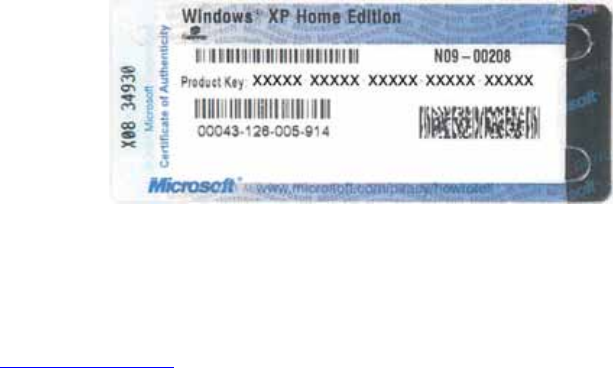
Microsoft Certificate of Authenticity
www.gateway.com
3
Microsoft Certificate of Authenticity
The Microsoft Certificate of Authenticity label found on the bottom of your
notebook includes the product key code for your operating system.
For more information
For more information about your notebook, visit Gateway’s Support page at
www.gateway.com or the Web address shown on your notebook’s label. The
Support page also has links to additional Gateway documentation and detailed
specifications.
CHAPTER 1: About this reference www.gateway.com
4

CHAPTER 2
5
Checking Out Your Gateway Notebook
•Identifying features
• Connecting the AC adapter
• Connecting the dial-up modem
• Connecting to a cable or DSL modem or to an Ethernet
network
• Starting your notebook
• Turning off your notebook
• Restarting (rebooting) your notebook
• Using the status indicators
•Using the keyboard
• Using the EZ Pad touchpad
•Adjusting the volume
• Turning your wireless radio on or off
• Using the CD or DVD drive
• Using the memory card reader
• Inserting and removing an Express Card
• Changing batteries
• Recalibrating the battery
• Ordering accessories
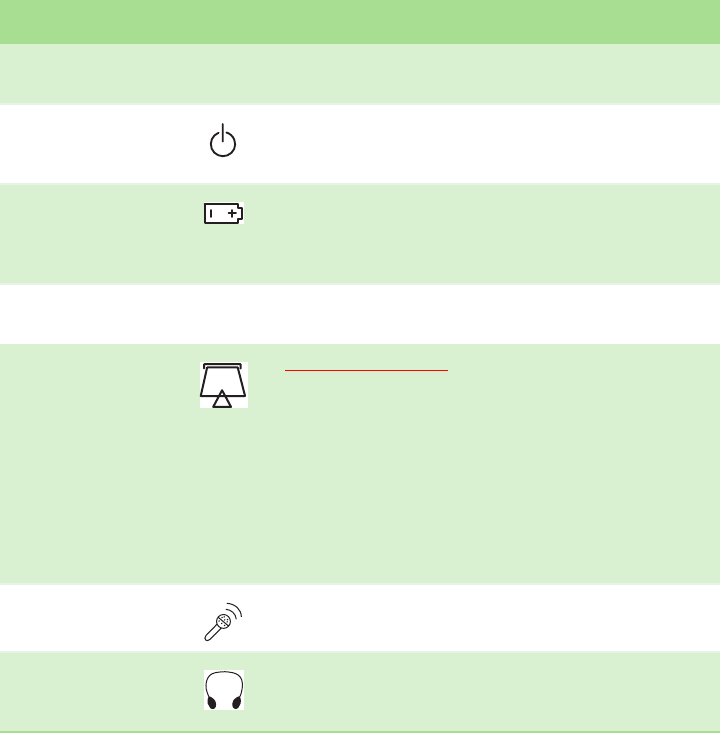
CHAPTER 2: Checking Out Your Gateway Notebook www.gateway.com
6
Identifying features
Front
Component Icon Description
LCD panel release
latch
Press to open the LCD panel.
Power indicator ■LED on - notebook is on.
■LED blinking - notebook is in Standby mode.
■LED off - notebook is off.
Battery charge
indicator
■LED blue - battery is fully charged.
■LED purple - battery is charging.
■LED blinking red - battery charge is very low.
■LED solid red - battery is malfunctioning.
Speakers Provide audio output when headphones or
amplified speakers are not plugged in.
Memory card
reader
<Verify card types> Insert a memory card from a
digital camera, MP3 player, PDA, or cellular
telephone into the memory card reader. For more
information, see “Using the memory card reader”
on page 25. The memory card reader supports
Memory Stick®, Memory Stick Pro®,
MultiMediaCard™, Secure Digital™, xD Picture Card,
Mini Secure Digital™, and RS-MultiMediaCard™.
Note: RS-Multimedia Card and Mini Secure Digital
cards require the use of an adapter that is available
with the media.
Microphone jack Plug a microphone into this jack.
Headphone jack Plug amplified speakers or headphones into this
jack. The built-in speakers are turned off when
speakers or headphones are plugged into this jack.
Microphone
jack
Headphone jack
Speaker
Battery charge indicator
LCD panel release latch
Speaker
Power indicator
Memory card reader

Identifying features
www.gateway.com
7
Left
Right
Component Icon Description
Ventilation fan Helps cool internal components.
Warning: Do not work for long periods with the notebook
resting on your lap. If the air vents are blocked, the
notebook may become hot enough to harm your skin.
Caution: Do not block or insert objects into these slots. If
these slots are blocked, your notebook may overheat
resulting in unexpected shutdown or permanent damage
to the notebook.
Caution: Provide adequate space around your notebook
so air vents are not obstructed. Do not use the notebook
on a bed, sofa, rug, or other similar surface.
USB ports Plug USB devices (such as a diskette drive, flash drive,
printer, scanner, camera, keyboard, or mouse) into these
ports.
IEEE 1394 port Plug an IEEE 1394 (also known as Firewire® or i.Link®) device
(such as a digital camcorder) into this 4-pin IEEE 1394 port.
Express Card
slot
Insert one Type 54 Express Card into this slot. For more
information, see “Inserting and removing an Express Card”
on page 27.
Kensington lock slot CD or DVD drive
S-Video out jack
Monitor port
USB ports
Component Icon Description
CD or DVD drive Insert CDs or DVDs into this drive. For more information,
see “Using the CD or DVD drive” on page 24. To
determine the type of drive in your notebook, examine
the drive tray’s plastic cover and compare the logo to
those listed in “Identifying drive types” on page 24.
IEEE 1394 port
PC Card slot
Modem jack
USB ports
Ventilation fan
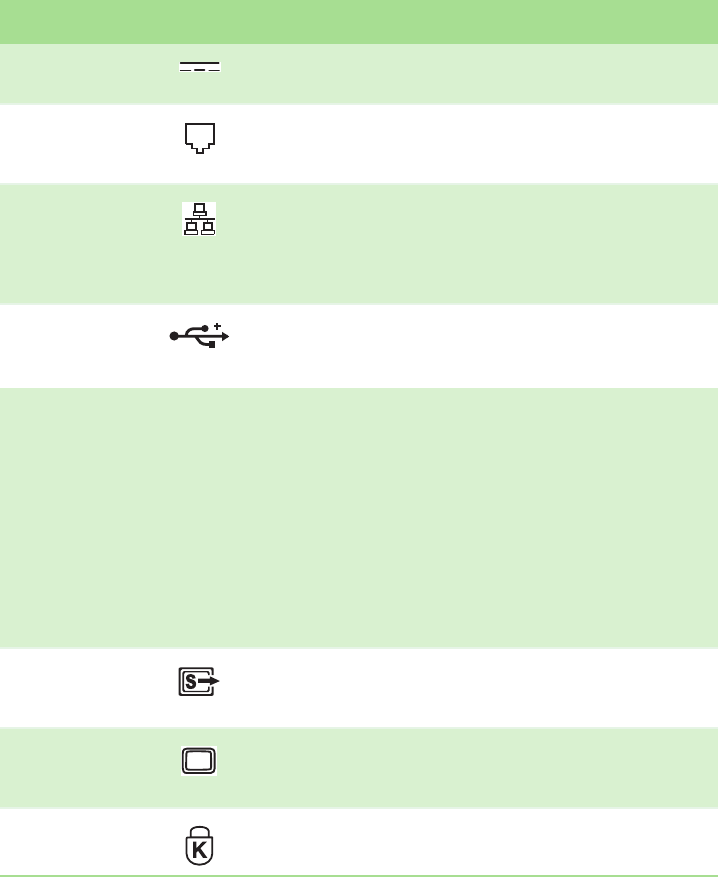
CHAPTER 2: Checking Out Your Gateway Notebook www.gateway.com
8
Back
Component Icon Description
Power
connector
Plug the AC adapter cable into this connector.
Modem jack Plug a dial-up modem cable into this jack. For more
information, see “Connecting the dial-up modem” on
page 12.
Ethernet jack Plug an Ethernet network cable into this jack. The other
end of the cable can be plugged into a cable modem,
DSL modem, or an Ethernet network jack. For more
information, see “Connecting to a cable or DSL modem
or to an Ethernet network” on page 13.
USB ports Plug USB devices (such as a diskette drive, flash drive,
printer, scanner, camera, keyboard, or mouse) into these
ports.
Ventilation fan Helps cool internal components.
Warning: Do not work for long periods with the
notebook resting on your lap. If the air vents are
blocked, the notebook may become hot enough to
harm your skin.
Caution: Do not block or insert objects into these slots.
If these slots are blocked, your notebook may overheat
resulting in unexpected shutdown or permanent
damage to the notebook.
Caution: Provide adequate space around your
notebook so air vents are not obstructed. Do not use the
notebook on a bed, sofa, rug, or other similar surface.
S-Video out jack Plug an S-Video device, such as a television, into this
jack. For more information, see “Viewing the display on
a television” on page 30.
Monitor port Plug an analog VGA monitor or projector into this port.
For more information, see “Viewing the display on a
projector or monitor” on page 28.
Kensington™
lock slot
Secure your notebook to an object by connecting a
Kensington cable lock to this slot.
Power connector Ethernet jack

Identifying features
www.gateway.com
9
Bottom
Component Icon Description
Battery lock Slide to unlock the battery. For more information, see
“Changing batteries” on page 31.
Battery latch Slide to release the battery. For more information, see
“Changing batteries” on page 31.
Battery Provides power when the notebook is not plugged into
AC power.
Hard drive bay The hard drive is located in this bay. For more
information, see “Replacing the hard drive kit” on
page 42.
Memory bay Install a memory module into this bay. For more
information, see “Adding or replacing memory
modules” on page 36.
Customer Care
label
Includes the Customer Care contact information. For
more information, see “Gateway contact information”
on page 2.
Battery latch
Memory
bay/Hard
drive bay
Battery lock
Battery
Customer
care label
Ventilation
fan

CHAPTER 2: Checking Out Your Gateway Notebook www.gateway.com
10
Keyboard area
Component Icon Description
Power
button
Press to turn the power on or off. You can also configure the
power button for Standby/Resume mode. For more
information on configuring the power button mode, see
“Changing Power-Saving Settings” in the online User Guide.
Keyboard Provides all the features of a full-sized, computer keyboard.
For more information, see “Using the keyboard” on
page 17.
Status
indicators
Inform you when a drive is in use or when a button has been
pressed that affects how the keyboard is used. For more
information, see “Using the status indicators” on page 16.
Touchpad Provides all the functionality of a mouse. For more
information, see “Using the EZ Pad touchpad” on page 21.
Live Launch
button
Press to run CyberLink PowerCinema and use the
multimedia features of your notebook without running
Windows XP. For more information, see “Using CyberLink
PowerCinema” on page 14.
Multimedia
buttons
Press these buttons to control the playback of multimedia.
For more information, see “Using the multimedia buttons”
on page 20.
Status indicators
Power button
Keyboard
Touch
p
ad
Live Launch
button

Connecting the AC adapter
www.gateway.com
11
Connecting the AC adapter
Warning
Do not attempt to disassemble the AC
adapter. The AC adapter has no
user-replaceable or user-serviceable
parts inside. The AC adapter has
dangerous voltages that can cause
serious injury or death. Contact Gateway
about returning defective AC adapters.
Caution
Make sure that you use the AC adapter
that came with your notebook or one of
the same type purchased from Gateway.
Replace the power cord if it becomes
damaged. The replacement cord must be
of the same type and voltage rating as
the original cord or your notebook may
be damaged.
Important
If the battery is not fully charged before
you use your notebook on battery power
for the first time, the battery life may be
much shorter than you expect. If the
battery life seems short even after being
charged for three hours, the battery may
need to be recalibrated. For information
on recalibrating the battery, see
“Recalibrating the battery” on page 32.
Important
If the battery charge indicator does not
turn blue after three hours, contact
Gateway Customer Care at
www.gateway.com.
You can run your notebook using an AC adapter or your notebook’s battery. The
battery was shipped to you partially charged. You should use the AC adapter
right away to fully charge the battery. Allow three hours for the battery to fully
charge.
To connect the AC adapter:
1Connect the power cord to the AC adapter.
2Connect the AC adapter to your notebook’s power connector.
3Plug the power cord into a wall outlet. The battery charge indicator turns
on (see “Front” on page 6 for the location of the battery charge indicator).
If the battery charge indicator does not turn on, complete the following
steps until it turns on:
aUnplug the adapter from your notebook, then plug it back in.
bPress Fn+F1 to toggle the status lights on and off.
4When you finish using your notebook for the first time, turn off your
notebook and leave your notebook connected to AC power until the
battery charge indicator turns blue.

CHAPTER 2: Checking Out Your Gateway Notebook www.gateway.com
12
Protecting from power source problems
Warning
High voltages can enter your notebook
through both the power cord and the
modem connection. To protect your
notebook and avoid electrical shock, use
a surge protector. If you have a telephone
modem, use a surge protector that has a
modem jack. If you have a cable modem,
use a surge protector that has an
antenna/cable TV jack. During an
electrical storm, unplug both the surge
protector and the modem.
During a power surge, the voltage level of electricity coming into your notebook
can increase to levels far above normal levels and cause data loss or system
damage. Protect your notebook and peripheral devices by connecting them to
a surge protector, which absorbs voltage surges and prevents them from
reaching your notebook.
Connecting the dial-up modem
Warning
To reduce the risk of fire, use only No. 26
AWG or larger telecommunications line
cord.
Your notebook has a built-in 56K modem that you can use to connect to a
standard telephone line.
To connect the modem:
1Insert one end of the modem cable into the modem jack on the back
of your notebook.
2Insert the other end of the modem cable into a telephone wall jack. The
modem will not work with digital or PBX telephone lines.
3Start your notebook, then start your communications program.

Connecting to a cable or DSL modem or to an Ethernet network
www.gateway.com
13
Connecting to a cable or DSL modem or to an Ethernet
network
Your notebook has a network jack that you can use to connect to a cable or DSL
modem or to an Ethernet network.
To connect to a cable or DSL modem or to an Ethernet network:
1Insert one end of the network cable into the network jack on the back
of your notebook.
2Insert the other end of the network cable into a cable modem, DSL
modem, or Ethernet network jack.
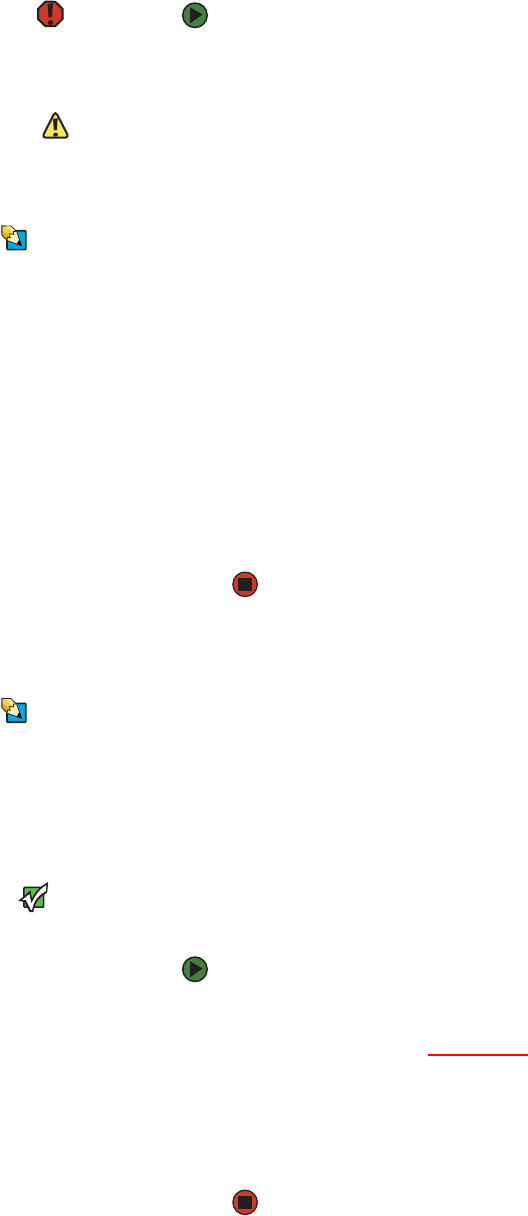
CHAPTER 2: Checking Out Your Gateway Notebook www.gateway.com
14
Starting your notebook
Warning
Do not work for long periods with the
notebook resting on your lap. If the air
vents are blocked, the notebook may
become hot enough to harm your skin.
Caution
Provide adequate space around your
notebook so air vents are not obstructed.
Do not use the notebook on a bed, sofa,
rug, or other similar surface.
Tips & Tricks
For more information about changing
the power button mode, see “Changing
Power-Saving Settings” in the online User
Guide.
To start your notebook:
1Press the latch on the front of your notebook, then lift the LCD panel.
2Press the power button located above the keyboard.
3If you are starting your notebook for the first time, follow the on-screen
instructions to set up your notebook.
Waking up your notebook
Tips & Tricks
For more information about Standby
mode, see “Changing power modes” in
the online User Guide.
When you have not used your notebook for several minutes or if you close the
LCD panel without turning off your notebook, it may enter a power-saving
mode called Standby. While in Standby, the power indicator flashes. If your
notebook is in Standby mode, press the power button to “wake” it up.
Using CyberLink PowerCinema
Important
Your notebook must be turned off or in
Hibernate mode to use CyberLink
PowerCinema. For more information
about Hibernate mode, see “Changing
power modes” in the online User Guide.
By pressing the Live Launch button you can use CyberLink PowerCinema to
access the multimedia features of your notebook without running Windows XP.
To use CyberLink PowerCinema:
1Slide the latch on the front of your notebook, then lift the LCD panel.
2Press the Live Launch <get icon> button located above the keyboard.
For the location of the Live Launch button, see “Keyboard area” on
page 10. The notebook will turn on, and the CyberLink PowerCinema
window opens.
3Use the touchpad or arrow keys to select a multimedia feature you want
to use, or select Help for a brief tutorial on using the program.

Turning off your notebook
www.gateway.com
15
Turning off your notebook
Important
If for some reason you cannot use the
Turn Off Computer option in Windows to
turn off your notebook, press and hold
the power button for about five seconds,
then release it.
To turn off your notebook:
1Click Start, then click Turn Off Computer. The Turn Off Computer dialog
box opens.
2Click Turn Off. Windows shuts down and turns off your notebook.
Restarting (rebooting) your notebook
Important
If your notebook does not turn off
immediately, complete the following
steps until the notebook turns off:
1. Press and hold the power button for
about five seconds, then release it.
2. Unplug the power cord and remove the
battery for more than 10 seconds.
If your notebook does not respond to keyboard, touchpad, or mouse input, you
may have to close programs that are not responding. If closing unresponsive
programs does not restore your notebook to normal operation, you may have
to restart (reboot) your notebook.
To close unresponsive programs and restart your notebook:
1Press CTRL+ALT+DEL. The Windows Security dialog box opens.
2Click Task Manager. The Windows Task Manager dialog box opens.
3Click the program that is not responding.
4Click End Task.
5Click X in the top-right corner of the Windows Task Manager dialog box.
6If your notebook does not respond, turn it off, wait ten seconds, then turn
it on again.
As a part of the regular startup process, a program to check the disk status
runs automatically. When the checks are finished, Windows starts.

CHAPTER 2: Checking Out Your Gateway Notebook www.gateway.com
16
Using the status indicators
Important
If none of the indicators are on, you may
need to press FN+F1 to toggle the status
indicators on.
Status indicators inform you when a drive is being used or when a button has
been pressed that affects how the keyboard is used. The status indicators are
located on the right side of the keyboard.
Indicator Icon Description
AC power ■LED on - AC power is connected.
■LED off - AC power is not connected.
Wireless network
(optional)
■LED on - wireless IEEE 802.11 radio is turned on.
■LED off - wireless IEEE 802.11 radio is turned off.
Caps lock ■LED on - caps lock is turned on.
■LED off - caps lock is turned off.
Num lock ■LED on - numeric keypad is turned on.
■LED off - numeric keypad is turned off.
Hard drive ■LED blinking - hard drive is being accessed.
■LED off - hard drive is not being accessed.
Hard drive
Caps lock
Num lock
Wireless network
Disc drive
A
1

Using the keyboard
www.gateway.com
17
Using the keyboard
Tips & Tricks
You can attach an external keyboard to
the notebook using a USB port. You do
not need to shut down the notebook to
connect a USB keyboard.
Your notebook features a full-size keyboard that functions the same as a desktop
computer keyboard. Many of the keys have been assigned alternate functions,
including shortcut keys for Windows, function keys for specific system
operations, and the Num Lock keys for the numeric keypad.
Key types
The keyboard has several different types of keys. Some keys perform specific
actions when pressed alone and other actions when pressed in combination
with another key.
Function keys/ System keys
Navigation
keys
FN key Windows key
Numeric
keypad
Application key Arrow keys
Key type Icon Description
Function
keys
Press these keys labeled F1 to F12 to perform actions in
programs. For example, pressing F1 may open help.
Each program uses different function keys for different
purposes. See the program documentation to find out more
about the function key actions.
System keys Press these colored keys in combination with the FNkey to
perform specific actions. For more information, see “System
key combinations” on page 18.
Navigation
keys
Press these keys to move the cursor to the beginning of a line,
to the end of a line, up the page, down the page, to the
beginning of a document, or to the end of a document.
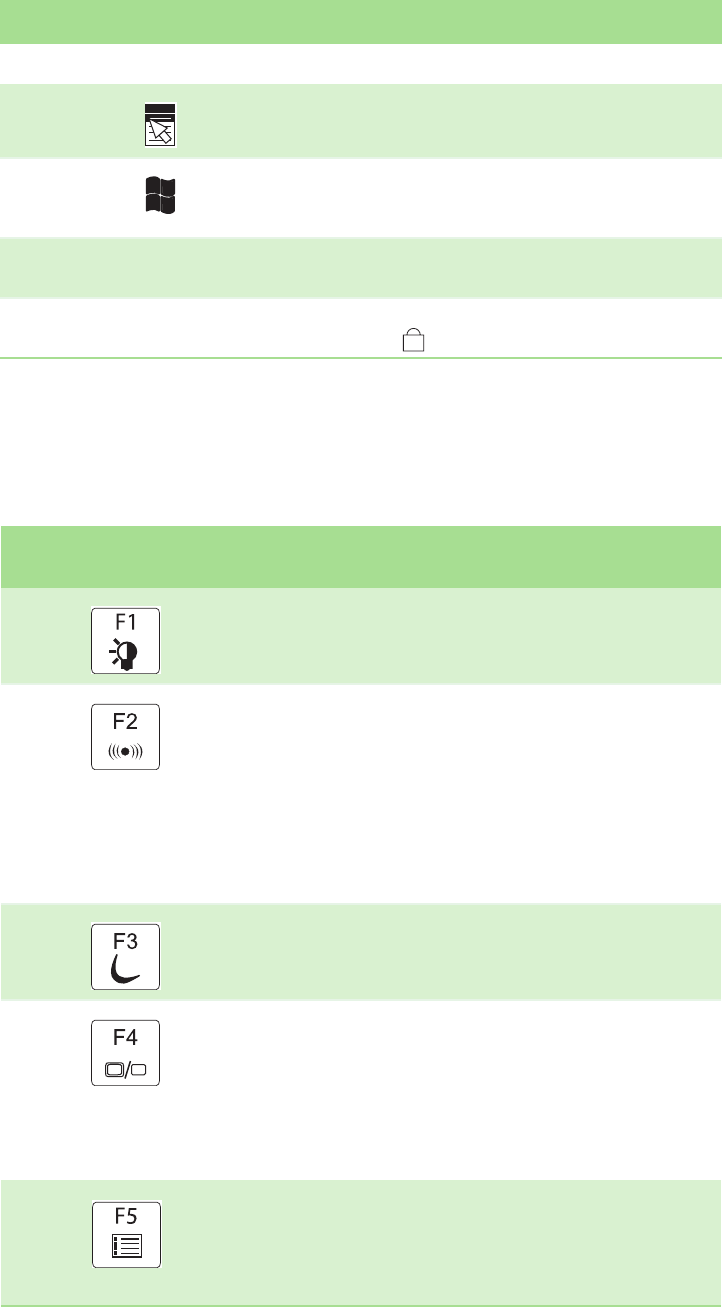
CHAPTER 2: Checking Out Your Gateway Notebook www.gateway.com
18
System key combinations
When you press the FN key and a system key at the same time, your notebook
performs the action identified by the text or icon on the key.
Arrow keys Press these keys to move the cursor up, down, right, or left.
Application
key
Press this key for quick access to shortcut menus and help
assistants in Windows.
Windows
key
Press this key to open the Windows Start menu. This key can
also be used in combination with other keys to open utilities
like F(Search utility), R(Run utility), and E(Explorer utility).
FN key Press the FNkey in combination with a colored system key to
perform a specific action.
Numeric
keypad
Use these keys to type numbers when the numeric keypad
is turned on. Press FN+ to turn on the numeric keypad.
Key type Icon Description
1
Press and hold FN, then
press this system key... To...
Toggle the status indicators on or off. For more
information, see “Using the status indicators” on
page 16.
Turn the optional wireless network on or off. For more
information, see “Wireless Networking” in your online
User Guide.
Warning: Radio frequency wireless communication
can interfere with equipment on commercial aircraft.
Current aviation regulations require wireless devices
to be turned off while traveling in an airplane.
IEEE 802.11g, IEEE 802.11b, and IEEE 802.11a
communication devices are examples of devices that
provide wireless communication.
Enter Standby mode. Press the power button to leave
Standby mode. For more information, see “Changing
Power-Saving Settings” in your online User Guide.
Toggle the notebook display in the following order:
■The LCD
■An external monitor or projector (a monitor or
projector must be plugged into the monitor port on
your notebook)
■Both displays at the same time
For more information, see “Viewing the display on a
projector or monitor” on page 28.
Display the power status box in the upper-left corner
of your display. The box shows the battery charge
level, the BIOS version, and whether the optional
wireless network is being used. Press the key
combination again to close this box.
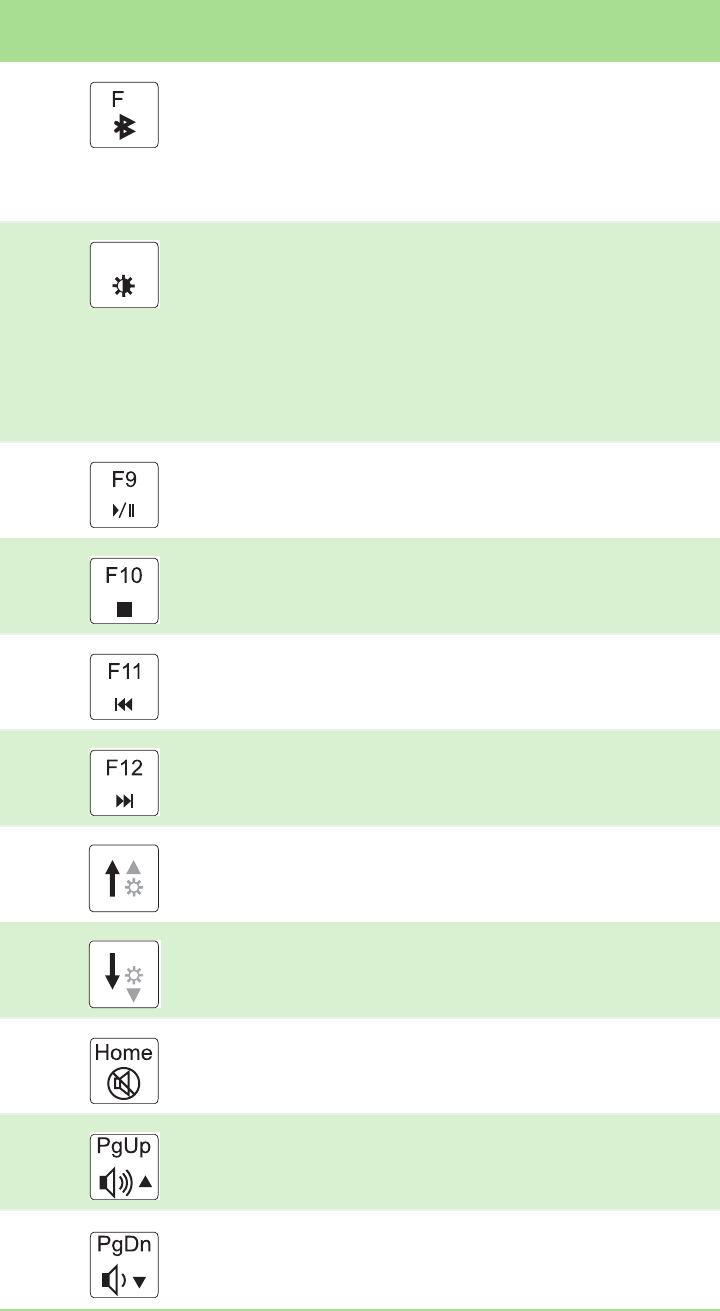
Using the keyboard
www.gateway.com
19
Turn the optional Bluetooth feature on or off.
Warning: Radio frequency wireless communication
can interfere with equipment on commercial aircraft.
Current aviation regulations require wireless devices
to be turned off while traveling in an airplane.
Bluetooth communication devices are examples of
devices that provide wireless communication.
Increase the LCD panel brightness above the normal
brightest setting. Use this feature in bright lighting
situations, such as outside in bright sunlight.
Press a second time to decrease the brightness below
the normal lowest brightness setting. Use this feature
in dim lighting situations.
Press a third time to return the display to the normal
brightness setting.
Important: Using this feature will affect battery
performance.
Play or pause the CD or DVD.
Stop playing the CD or DVD.
Skip back one CD track or DVD chapter.
Skip ahead one CD track or DVD chapter.
Increase the brightness of the display.
Decrease the brightness of the display.
Mute the sound. Press the key combination again to
restore the sound. For more information, see
“Adjusting the volume” on page 23.
Increase volume. For more information, see “Adjusting
the volume” on page 23.
Decrease volume. For more information, see
“Adjusting the volume” on page 23.
Press and hold FN, then
press this system key... To...
6
F8
-+
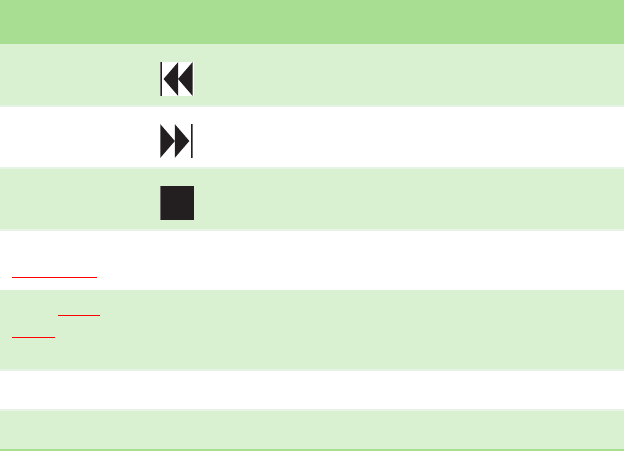
CHAPTER 2: Checking Out Your Gateway Notebook www.gateway.com
20
Using the multimedia buttons
Press the multimedia buttons to control the playback of multimedia on your
notebook.
Button Icon Press to...
Back Skip back one chapter, song, or track.
Next Skip ahead one chapter, song, or track.
Stop Stop playing.
Play/Pause
<get icon> Start or pause playing.
Mute <get
icon> Mute the sound. Press again to restore the
sound. For more information, see “Adjusting
the volume” on page 23.
Volume down —Press to decrease the volume.
Volume up +Press to increase the volume.
E-mail
Internet
Search
Music player
Volume down Volume up

Using the EZ Pad touchpad
www.gateway.com
21
Using the EZ Pad touchpad
Tips & Tricks
For instructions on how to adjust the
double-click speed, pointer speed,
right-hand or left-hand configuration,
and other touchpad settings, see
“Changing the mouse or touchpad
settings” in the online User Guide.
Tips & Tricks
You received your notebook with the EZ
Pad touchpad set to only accept clicking
by using the touchpad buttons. You can
change this feature to allow tapping on
the touchpad to simulate clicking the left
button. For more information, see
“Changing the mouse or touchpad
settings” in the online User Guide.
The EZ Pad™ consists of a touchpad, two buttons, and a scroll zone.
When you move your finger on the touchpad, the pointer (arrow) on the screen
moves in the same direction. You can use the scroll zone to scroll through
documents. Use of the scroll zone may vary from program to program.
You can use the EZ-Pad left and right buttons below the touchpad to select
objects.
Touchpad
Left button
Right button
Scroll
zone
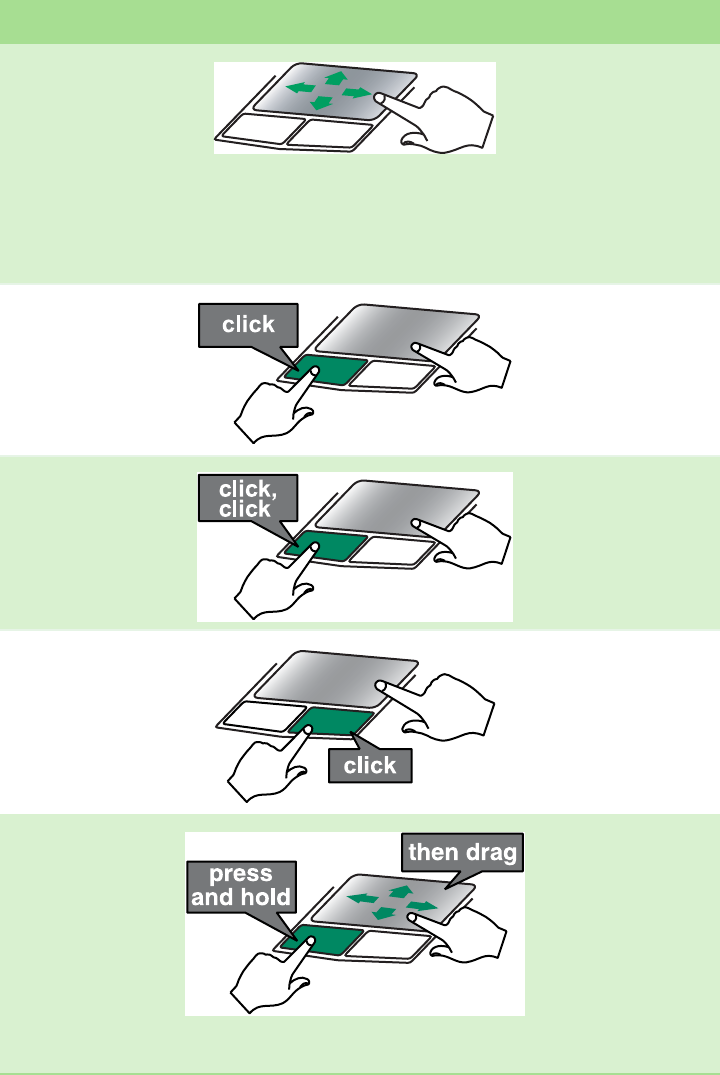
CHAPTER 2: Checking Out Your Gateway Notebook www.gateway.com
22
To... Do this...
Move the pointer
on the screen.
Move your finger
around on the
touchpad. If you run
out of space and
need to move the
pointer farther, lift
your finger, move it
to the middle of the
touchpad, then
continue moving
your finger.
Select an object on
the screen.
Position the pointer
over the object.
Quickly press and
release the left
button once. This
action is called
clicking.
Start a program or
open a file or
folder.
Position the pointer
over the object.
Press the left button
twice in rapid
succession. This
action is called
double-clicking.
Access a shortcut
menu or find more
information about
an object on the
screen.
Position the pointer
over the object.
Quickly press and
release the right
button once. This
action is called
right-clicking.
Move an object on
the screen.
Position the pointer
over the object.
Press the left button
and hold it down,
then use the
touchpad to move
(drag) the object to
the appropriate part
of the screen.
Release the button
to drop the object
where you want it.

Adjusting the volume
www.gateway.com
23
Adjusting the volume
Tips & Tricks
For instructions on how to adjust the
volume in Windows, see “Adjusting the
Volume” in the online User Guide.
You can use the volume control to adjust the overall volume of your notebook.
To adjust the overall volume level using hardware controls:
■If you are using external speakers, turn the knob on the front of the
speakers.
-OR-
Use the mute and volume control buttons above the keyboard. For more
information, see “Using the multimedia buttons” on page 20.
-OR-
Use the mute and volume control buttons on the keyboard. For more
information, see “System key combinations” on page 18.
Turning your wireless radio on or off
Warning
Radio frequency wireless communication
can interfere with equipment on
commercial aircraft. Current aviation
regulations require wireless devices to be
turned off while traveling in an airplane.
IEEE 802.11a, IEEE 802.11b, IEEE 802.11g,
and Bluetooth communication devices
are examples of devices that provide
wireless communication.
Warning
In environments where the risk of
interference to other devices or services is
harmful or perceived as harmful, the
option to use a wireless device may be
restricted or eliminated. Airports,
hospitals, and oxygen or flammable gas
laden atmospheres are limited examples
where use of wireless devices may be
restricted or eliminated. When in
environments where you are uncertain of
the sanction to use wireless devices, ask
the applicable authority for
authorization prior to using or turning on
the wireless device.
Tips & Tricks
For more information about using your
notebook on a wireless network, see
“Wireless Networking” in the online User
Guide.
Tips & Tricks
For more information about using
Bluetooth, click Start, All Programs,
My Bluetooth Places. When the My
Bluetooth Places window opens, click
Help, then click Bluetooth Help Topics.
Your Gateway notebook may have a factory-installed wireless networking card.
To turn the wireless IEEE 802.11 radio on or off:
■Press FN + F2. The wireless status indicator turns on or off. For the location
of the wireless status indicator, see “Using the status indicators” on
page 16.
To turn the Bluetooth radio on or off:
■Press FN + F6. The first time you use Bluetooth, you need to configure your
notebook using the Initial Bluetooth Configuration Wizard.
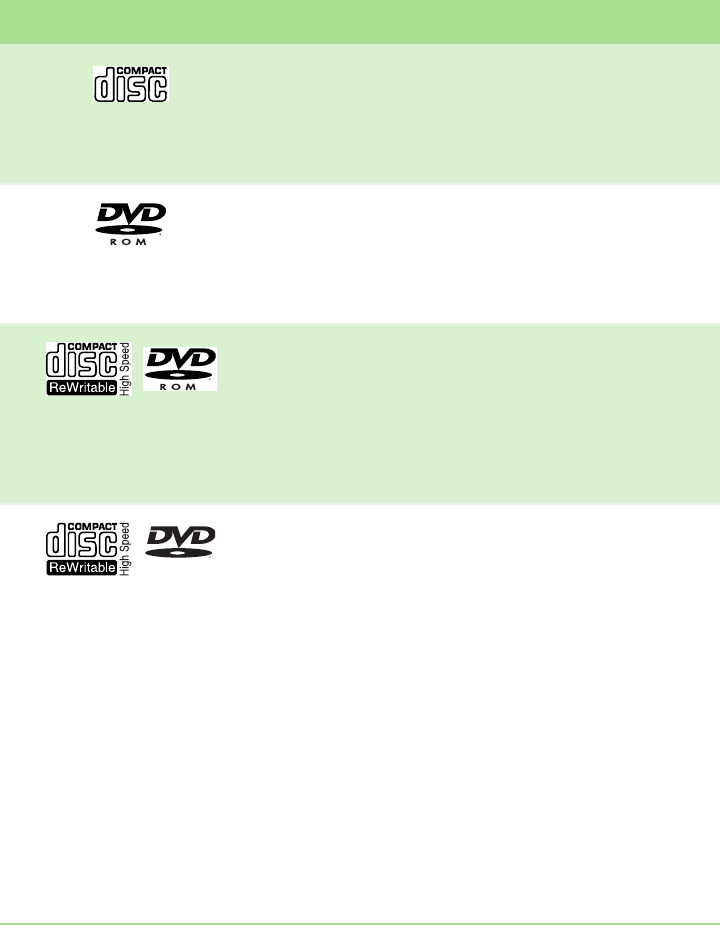
CHAPTER 2: Checking Out Your Gateway Notebook www.gateway.com
24
Using the CD or DVD drive
You can use your notebook to enjoy a wide variety of multimedia features.
Identifying drive types
Your Gateway notebook may contain one of the following drive types. Look on
the front of the drive for one or more of the following logos:
If your drive has this logo... This is your drive type... Use your drive for...
CD drive Installing programs,
playing audio CDs, and
accessing data. You
cannot use this drive to
create CDs or DVDs or
play DVDs.
DVD drive Installing programs,
playing audio CDs,
playing DVDs, and
accessing data. You
cannot use this drive to
create CDs or DVDs.
Combination
DVD/CD-RW drive Installing programs,
playing audio CDs,
playing DVDs, accessing
data, and recording
music and data to
recordable CDs. You
cannot use this drive to
create DVDs.
Multi-format double
layer DVD±RW/CD-RW
drive
Installing programs,
playing audio CDs,
playing DVDs, accessing
data, recording music
and data to CD-R or
CD-RW discs, and
recording video and data
to DVD-R, DVD+R,
DVD-RW, DVD+RW, or
double layer DVD+R
discs.
Note: To use the double
layer capability of the
double layer recordable
DVD drive, the blank
DVDs you purchase must
state Double Layer, Dual
Layer, or DL. Using other
types of blank media will
result in less capacity.
ROM/R/RW

Using the memory card reader
www.gateway.com
25
Inserting a CD or DVD
[
To insert a CD or DVD:
1Press the eject button on the CD or DVD drive. After the tray opens slightly,
pull the disc tray completely open.
Important
When you place a single-sided disc in the
tray, make sure that the label side is
facing up. If the disc has two playable
sides, place the disc so the name of the
side you want to play is facing up.
2Place the disc in the tray with the label facing up, then press down carefully
on the disc until it snaps into place.
3Push the tray in until it is closed.
Using the memory card reader
You can use memory cards to transfer pictures from a digital camera to your
notebook. You can also use the memory card reader to transfer data between
your notebook and a device that uses memory cards, such as a PDA, MP3 player,
or cellular telephone.
Memory card types
Important
RS-Multimedia Card and Mini Secure
Digital cards require the use of an
adapter that is available with the media.
<Verify card types> The memory card reader supports Memory Stick®, Memory
Stick Pro®, MultiMediaCard™, Secure Digital™, xD Picture Card, Mini Secure
Digital™, and RS-MultiMediaCard™.
Inserting a memory card
To insert a memory card:
■Insert the memory card into the memory card slot with the label facing
up and the arrow on the label pointing towards the notebook.
Eject button
Manual eject hole
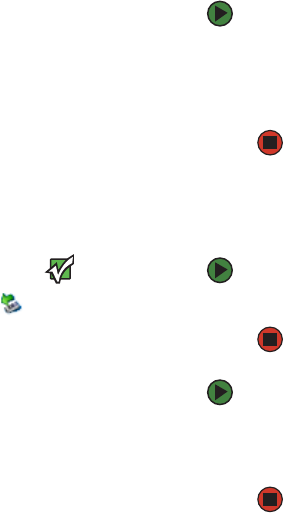
CHAPTER 2: Checking Out Your Gateway Notebook www.gateway.com
26
Using a memory card
To access a file on a memory card:
1Click Start, then click My Computer.
2Double-click the drive letter (for example, the E: drive), then double-click
the file name.
Removing a memory card
Important
Do not use the remove
hardware icon in the taskbar to
remove the memory card. If you use the
remove hardware icon, your notebook
may not recognize your memory card
reader until you restart your notebook.
To remove a memory card from the top slot:
■Pull the memory card out of the notebook.
To remove a memory card from the bottom slot:
1Press the memory card into the notebook. The card pops out part way.
2Pull the memory card out of the notebook.

Inserting and removing an Express Card
www.gateway.com
27
Inserting and removing an Express Card
Your notebook has a Express Card slot. This slot accepts one Type 54 Express
Card. You do not need to restart your notebook when changing most cards
because your notebook supports hot-swapping. Hot-swapping means that you
can insert an Express Card while your notebook is running. If your Express Card
does not work after hot-swapping, see the Express Card manufacturer’s
documentation for further information.
To insert an Express Card:
■Push the card firmly into the Express Card slot, label-side up, until the outer
edge of the card is flush with the side of your notebook.
To remove an Express Card:
Important
If the remove hardware icon does not
appear on the taskbar, click the show
hidden icons button.
1Click the remove hardware icon in the taskbar, the Express Card name,
then click Stop.
-OR-
Turn off your notebook.
2Pull the Express Card out of your notebook.

CHAPTER 2: Checking Out Your Gateway Notebook www.gateway.com
28
Installing a printer, scanner, digital camera, or other
peripheral device
Important
Before you install a printer, scanner, or
other peripheral device, see the device
documentation and installation
instructions.
Tips & Tricks
For the location of these ports on your
notebook, see the poster or hardware
guide.
Help and Support
For more information about installing
peripheral devices, click Start, then click
Help and Support. Type the keyword
installing devices in the Search box,
then click the arrow.
Your notebook has one or more of the following ports: IEEE 1394 (also known
as Firewire® or i.Link®), Universal Serial Bus (USB), and S-Video (digital video). You
use these ports to connect peripheral devices such as printers, scanners, and
digital cameras to your notebook.
IEEE 1394 and USB ports support plug-and-play and hot swapping, which means
that your notebook will usually recognize such a device whenever you plug it
into the appropriate port. When you use an IEEE 1394 or USB device for the first
time, your notebook will prompt you to install any software the device needs.
After doing this, you can disconnect and reconnect the device at any time.
Installing a USB printer or scanner
USB devices may have special installation instructions. See your USB device’s
installation guide.
Viewing the display on a projector or monitor
Important
Press FN+F4 to switch between viewing
the display on the LCD panel and viewing
the display on the projector or monitor.
Important
If an external monitor or projector is
connected and you close the LCD panel,
your notebook may turn off the LCD
panel, but will not enter Standby mode.
Tips & Tricks
For the location of the VGA port on your
notebook, see “Left” on page 7.
You can use your notebook for giving presentations by connecting an external
monitor or projector to your monitor (VGA) port. Your notebook supports
simultaneous LCD and external display. Simultaneous display lets you control
the presentation from your notebook and at the same time face your audience.
To use a projector or external monitor:
1Turn off your notebook.
2Plug the projector or monitor cable into the VGA port on your
notebook.
3Turn on your notebook.
4Plug the projector’s or monitor’s power cord into an AC power source and
turn it on. Windows recognizes the new hardware and searches for its
driver. You may need to install the driver from the disc supplied by the
manufacturer or download the driver from the manufacturer’s Web site.
5After the driver is installed, right-click any empty space on the desktop,
then click Properties. The Display Properties dialog box opens.
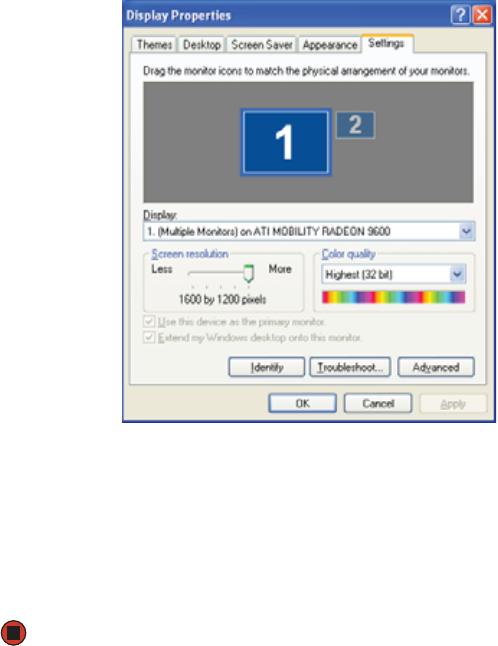
Viewing the display on a projector or monitor
www.gateway.com
29
6Click the Settings tab.
7Right-click the second monitor icon (labeled 2), then click Attached.
8Click Apply.
9Adjust properties such as Screen Resolution or Color Quality if
necessary.
10 Click OK.
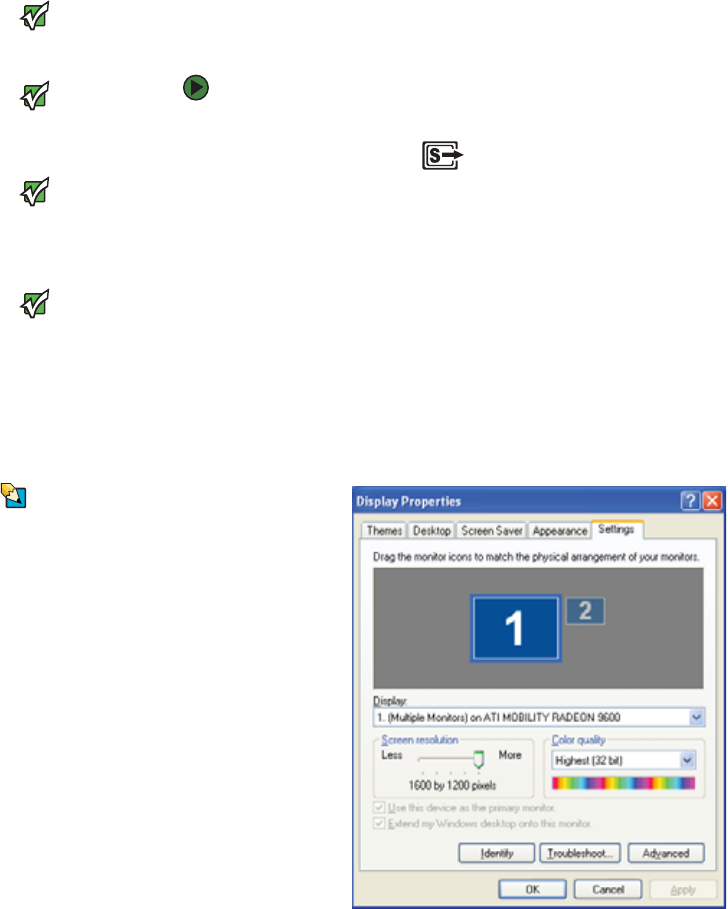
CHAPTER 2: Checking Out Your Gateway Notebook www.gateway.com
30
Viewing the display on a television
Important
The TV out feature is available only on
select Gateway notebooks.
Important
The dialog boxes shown in this section
are for demonstrative purposes only and
may not represent the screens on your
notebook.
Important
To turn on external video by default,
connect the television (or other external
video device) before starting your
notebook.
Important
Audio is not transmitted through an
S-Video out jack. Use the built-in speakers
or a set of headphones or external
powered speakers, or connect your
notebook to a stereo system using the
headphone jack to hear sound while
playing a DVD. DVD playback to a VCR
will be scrambled by copyright protection
software.
Tips & Tricks
For the location of the S-Video out jack on
your notebook, see “Left” on page 7.
The S-Video out jack on your notebook lets you view your notebook display on
a television screen using a standard S-Video cable.
To view your notebook display on a television:
1With your notebook off, connect one end of a standard S-Video cable to
the S-Video out jack on your notebook.
2Connect the other end of the cable to the Video in jack on your television
or VCR.
3Turn on the television or VCR.
4Start your notebook.
5Click Start, then click Control Panel. The Control Panel window opens. If
your Control Panel is in Category View, click Appearance and Themes.
6Click/Double-click the Display icon. The Display Properties dialog box
opens.
7Click the Settings tab.
8Click Advanced. The Plug and Play Properties dialog box opens.
9If you see an Intel Graphics tab, click it, then do the following:
aClick the Graphics Properties button.
bAdjust the television properties.
-OR-
If you see an ATI Catalyst tab, click it, then do the following:
cClick Advanced, then click Next.
dClick Ye s . The ATI Catalyst Control Center opens.

Connecting a video camera to your notebook
www.gateway.com
31
eClick Help. for instructions on adjusting the television properties.
Connecting a video camera to your notebook
Important
For more information about using the
IEEE 1394 port on your video camera, see
your camera’s documentation.
Tips & Tricks
For the location of the IEEE 1394 port on
your notebook, see “Right” on page 7.
Tips & Tricks
For more information about editing
video, see your User Guide.
Your notebook has a 4-pin IEEE 1394 port (also known as a Firewire® or i.Link®
port) for connecting devices such as a video camera.
To connect your video camera to your notebook:
1Connect one end of the IEEE 1394 cable to your video camera.
2Connect the other end of the cable to the IEEE 1394 port on your
notebook.
Changing batteries
Replacing the battery
Warning
Danger of explosion if battery is
incorrectly replaced.
Replace only with a battery specifically
manufactured for your Gateway
notebook. Discard used batteries
according to local hazardous material
regulations.
The battery used in this device may
present a fire or chemical burn hazard if
mishandled. Do not disassemble, heat
above 212°F (100°C), or incinerate.
Dispose of used battery promptly. Keep
away from children.
Caution
If your notebook is connected to AC
power, you can change the battery while
the notebook is turned on. If your
notebook is not plugged into an AC
outlet, you must turn the notebook off
while changing the battery or you will
lose any unsaved data.
To replace the battery:
1If your notebook is on and is connected directly to AC power, go to Step 2.
-OR-
If your notebook is on and is not plugged into an AC outlet, save your work
and turn off the notebook.
2Close the LCD panel.
3Turn your notebook over so the bottom is facing up.
4Slide the battery lock to the unlocked position.
5Slide the battery release latch.

CHAPTER 2: Checking Out Your Gateway Notebook www.gateway.com
32
6Lift the battery out of the notebook.
7Slide a recharged battery into the notebook until it snaps into place.
8Slide the battery lock to the locked position.
9Turn your notebook over.
10 Open the LCD panel and press the power button.
Recalibrating the battery
Important
Do not interrupt the battery recalibration
process. If recalibration is interrupted,
you must start the process over again.
If your notebook unexpectedly goes into Standby mode while you are using it
but the battery charge is not low, you may need to recalibrate your battery. You
should also recalibrate the battery periodically to maintain the accuracy of the
battery gauge.
To recalibrate the battery:
1Close all open files and programs.
2Connect your notebook to AC power and let the battery charge
completely.
3Disconnect the AC power and restart your notebook.
Important
Do not use your notebook during the
recalibration process. Do not connect the
AC adapter to your notebook during this
process, or you will interrupt the
recalibration process and will have to
start again.
4Completely discharge the battery by doing the following:
aFrom the desktop, right-click on the power icon, then select Adjust
Power Properties.
bClick the Power Schemes tab.
cClick the arrow button to open the Power Schemes list, then click
Always On.
dClick the Alarms tab.
eClick to clear the Low battery alarm and Critical battery alarm
check boxes. Let the battery drain until your notebook
automatically turns off.
5After the battery is completely drained, reconnect your notebook to AC
power.

Ordering accessories
www.gateway.com
33
6Charge the battery completely until the battery status indicator turns blue.
7When you are ready to use your notebook again, do the following:
aFrom the desktop, right-click on the power icon, then select Adjust
Power Properties.
bClick the Power Schemes tab.
cClick the arrow button to open the Power Schemes list, then click
the power scheme you want.
dClick the Alarms tab.
eClick to select the Low battery alarm and Critical battery alarm
check boxes.
The battery charge indicator now displays an accurate battery charge. If
the battery charge indicator does not show an accurate charge, contact
Gateway Customer Care at www.gateway.com.
Ordering accessories
To order accessories, visit the Accessory Store at www.gateway.com.
Batteries
If you run your notebook on battery power for extended periods, you may want
to buy an additional battery so you can swap batteries when necessary. See
“Changing batteries” on page 31 for more information about using an
additional battery.
Carrying cases
Gateway has large-capacity carrying cases if you need additional space for
accessories or supplies.
Memory
Large programs, such as multimedia games or graphics programs, use a lot of
memory. If your programs are running more slowly than you think they should,
try adding more memory. See “Adding or replacing memory modules” on
page 36 for more information.
Printers
You can attach almost any type of printer to your notebook. The most common
types are inkjet and laser printers, which print in color or black and white.
Inkjet printers and cartridges are relatively inexpensive, but they are slower than
laser printers. Using an inkjet color printer, you can print pictures, banners, and
greeting cards, as well as documents.
Laser printers and cartridges are more expensive, but they print much faster
than inkjet printers. Laser printers are better than inkjet printers when you are
printing large documents.
USB flash drive
Use a USB flash drive for storing files or transferring files to another computer.
CHAPTER 2: Checking Out Your Gateway Notebook www.gateway.com
34

CHAPTER 3
35
Maintaining and Upgrading Your Notebook
• Preventing static electricity discharge
• Adding or replacing memory modules
• Replacing the CD or DVD drive
• Replacing the hard drive kit
• Replacing the keyboard

CHAPTER 3: Maintaining and Upgrading Your Notebook www.gateway.com
36
Preventing static electricity discharge
Warning
To avoid exposure to dangerous electrical
voltages and moving parts, turn off your
notebook, unplug the power cord,
modem cable, and network cable, and
remove the batteries before opening the
case.
Warning
To prevent risk of electric shock, do not
insert any object into the vent holes of the
notebook.
Important
Before installing or replacing
components, you should read and
understand the information in this
section.
The components inside your notebook are extremely sensitive to static
electricity, also known as electrostatic discharge (ESD).
Before installing or replacing components, follow these guidelines:
■Avoid static-causing surfaces such as carpeted floors, plastic, and packing
foam.
■Remove components from their antistatic bags only when you are ready
to use them. Do not lay components on the outside of antistatic bags
because only the inside of the bags provide electrostatic protection.
■Always hold components by their edges. Avoid touching the edge
connectors. Never slide components over any surface.
■Wear a grounding wrist strap (available at most electronics stores) and
attach it to a bare metal part of your workbench or other grounded
connection.
■Touch a bare metal surface on your workbench or other grounded object.
Adding or replacing memory modules
Important
Use only memory modules designed for
your Gateway notebook.
Tools Required
You need a small Phillips screwdriver to
replace memory modules.
Your notebook uses memory modules called SO-DIMMs (Small Outline Dual
Inline Memory Modules). The modules are available in various capacities and
any module can be placed in any slot.
To add or replace memory modules:
1Follow the guidelines under “Preventing static electricity discharge” on
page 36.
2Turn off your notebook.
3Disconnect the AC adapter, modem cable, and network cable.
Memory
bay
Adding or replacing memory modules
www.gateway.com
37
4Disconnect all peripheral devices connected to the notebook and remove
any Express cards.
5Turn your notebook over so the bottom is facing up, then remove the
battery. For more information, see “Changing batteries” on page 31.
6Remove the memory bay cover screw and put it in a safe place.
7Slide the memory bay cover in the direction shown, then remove it.
CHAPTER 3: Maintaining and Upgrading Your Notebook www.gateway.com
38
8If you are removing a module, gently press outward on the clip at each
end of the memory module until the module tilts upward.
Clip
Clip

Adding or replacing memory modules
www.gateway.com
39
9Pull the memory module out of the slot.
10 Hold the new or replacement module at a 30-degree angle and press it
into the empty memory slot. This module is keyed so it can only be
inserted in one direction. If the module does not fit, make sure that the
notch in the module lines up with the tab in the memory bay.
11 Replace the memory bay cover, then replace the cover screw.
12 Insert the battery, then turn your notebook over.
13 Connect the power adapter, modem cable, and network cable, then turn
on your notebook.
14 Reconnect all peripheral devices and replace any Express cards.

CHAPTER 3: Maintaining and Upgrading Your Notebook www.gateway.com
40
Replacing the CD or DVD drive
If your CD or DVD drive becomes damaged, you can replace it with a similar drive
obtained from Gateway.
Important
Replace the CD or DVD drive only with a
similar drive provided by Gateway.
Tools Required
You need a small Phillips screwdriver to
replace the CD or DVD drive.
To replace the CD or DVD drive:
1Make sure that the CD or DVD drive is empty.
2Follow the guidelines under “Preventing static electricity discharge” on
page 36.
3Turn off your notebook.
4Disconnect the AC adapter, modem cable, and network cable.
5Disconnect all peripheral devices and remove any Express cards.
6Turn your notebook over so the bottom is facing up, then remove the
battery. For more information, see “Changing batteries” on page 31.
7With a small Phillips screwdriver, remove the CD or DVD drive screws, then
put them in a safe place.
Screw

Replacing the CD or DVD drive
www.gateway.com
41
8Insert a straightened paper clip into the CD or DVD drive’s manual eject
hole, push in the paper clip to eject the drive tray, then pull the drive tray
open.
9Carefully slide the drive out of the drive bay.
10 Slide the new CD or DVD drive into the drive bay. Make sure that the drive
fits securely in the bay.
11 Secure the CD or DVD drive with the screws removed in Step 7.
12 Insert the battery, then turn your notebook over.
13 Connect the power adapter, modem cable, and network cable, then turn
on your notebook.
14 Reconnect all peripheral devices and replace any Express cards.

CHAPTER 3: Maintaining and Upgrading Your Notebook www.gateway.com
42
Replacing the hard drive kit
Tools Required
You need a small Phillips screwdriver to
replace the hard drive kit.
If you would like more hard drive capacity, you can replace your original drive
with a higher-capacity drive.
To replace the hard drive kit:
1Create a Drivers and Applications Recovery disc. For more information, see
“Creating Drivers and Applications Recovery discs” in the online User
Guide.
2Print the “Recovering Your System” chapter from the online User Guide for
use in Step 20.
3Back up any data you want to transfer to the new hard drive. For more
information, see “Backing up files” in the online User Guide.
4Follow the guidelines under “Preventing static electricity discharge” on
page 36.
5Turn off your notebook.
6Disconnect the AC adapter, modem cable, and network cable.
7Disconnect all peripheral devices connected to the notebook and remove
any Express cards.
8Turn your notebook over so the bottom is facing up, then remove the
battery. For more information, see “Changing batteries” on page 31.
Hard
drive bay
Replacing the hard drive kit
www.gateway.com
43
9Remove the hard drive kit screw, then put it in a safe place.
10 Slide the hard drive out of the notebook in the direction shown.
11 If your new hard drive already includes the hard drive bracket, go to
Step 16.
-OR-
If you need to move the hard drive bracket from your old hard drive to
your new hard drive, go to Step 12.
Screw
Screw
Screw
Screw
Screw

CHAPTER 3: Maintaining and Upgrading Your Notebook www.gateway.com
44
12 Remove the four screws that secure the hard drive to the hard drive
bracket.
13 Remove the bracket from the old drive.
14 Place the new drive, label side up, onto the bracket so the screw holes line
up.
15 Replace the screws that secure the bracket to the drive.
16 Slide the new hard drive kit into your notebook, then replace the screw
that secures the hard drive kit to the notebook.
17 Insert the battery, then turn your notebook over.
18 Connect the power adapter, modem cable, and network cable
19 Turn on your notebook.
20 For instructions on installing Windows, your drivers, and your applications,
see the “Recovering Your System” chapter you printed in Step 2.
21 Reconnect all peripheral devices and replace any Express cards.
Screw
Screw
Screw
Screw

Replacing the keyboard
www.gateway.com
45
Replacing the keyboard
Important
Replace the keyboard only with a similar
keyboard provided by Gateway.
Tools Required
You need a small Phillips and a small
flat-blade screwdriver to replace the
keyboard.
If your keyboard becomes damaged, you can replace it with a similar keyboard
obtained from Gateway.
Removing the keyboard
To remove the keyboard:
1Follow the guidelines under “Preventing static electricity discharge” on
page 36.
2Turn off your notebook.
3Disconnect the AC adapter, modem cable, and network cable.
4Disconnect all peripheral devices connected to the notebook and remove
any Express cards.
5Turn your notebook over so the bottom is facing up, then remove the
battery. For more information, see “Changing batteries” on page 31.
6Remove the keyboard cover screw.
7Remove the memory bay cover screw and put it in a safe place.

CHAPTER 3: Maintaining and Upgrading Your Notebook www.gateway.com
46
8Slide the memory bay cover in the direction shown, then remove it.
9Remove the keyboard screw.
10 Turn the notebook over so the top is facing up.
11 Carefully open the LCD panel to the fully opened position.
Tips & Tricks
Inserting a piece of cloth between the
screwdriver and keyboard will help
prevent damage to the notebook.
12 Insert the small flat-blade screwdriver or non-marring tool under the
keyboard cover and gently pry it up.
13 Pull the old cover off the notebook. You will hear small snapping sounds
as the cover comes away from the notebook.
14 Gently lift the back edge of the keyboard.
Replacing the keyboard
www.gateway.com
47
15 With the back edge of the keyboard raised, carefully push it toward the
LCD panel to release the keyboard retaining tabs. Be careful not to damage
the LCD panel.
16 Rotate the keyboard toward you so it lies keys-down on top of your
notebook.

CHAPTER 3: Maintaining and Upgrading Your Notebook www.gateway.com
48
17 Lift the connector clip, then remove the cable. Be careful not to touch or
damage any other components.
18 Lift the old keyboard away from the notebook.
Connector

Replacing the keyboard
www.gateway.com
49
Installing the keyboard
To install the keyboard:
1Place the new keyboard keys-down on your notebook with the space bar
away from you.
Important
The keyboard cable is correctly oriented if
the cable is not twisted
2Make sure the keyboard connector clip is fully raised, insert the cable into
the connector, then lower the black connector clip back to lock the
connectors in place.
3Rotate the keyboard toward the LCD panel until the keyboard is
almost face-up.
4Insert the tabs on the front edge of the keyboard into the slots under the
palm rest. You may need to press down on the keyboard keys along the
front edge of the keyboard to seat the retaining tabs into their
corresponding slots.
5Gently press the keyboard down until it is flat all the way across. The
keyboard should easily fall into place. Be careful not to damage the
LCD panel.
Caution
If the cover is not correctly replaced, your
notebook could be damaged when you
try to close the LCD panel.
6Place the cover on the notebook, then press down on the cover in several
places until it clicks in place. The cover is correctly mounted when you can
run your finger along the cover and find no loose spots. The cover should
be flat all the way across.
7Close the LCD panel, then turn the notebook over so the bottom is facing
up.
8Replace the keyboard screw.
9Replace the keyboard cover screw.
10 Replace the memory bay cover.
11 Insert the battery, then turn your notebook over.
12 Connect the power adapter, modem cable, and network cable, then turn
on your notebook.

CHAPTER 3: Maintaining and Upgrading Your Notebook www.gateway.com
50
13 Reconnect all peripheral devices and replace any Express cards.

APPENDIX A
51
Safety, Regulatory, and Legal Information
• Important safety information
• Regulatory compliance statements
• Environmental information
•Notices

APPENDIX A: Safety, Regulatory, and Legal Information www.gateway.com
52
Important safety information
Warning
Always follow these instructions to help
guard against personal injury and
damage to your Gateway system.
Warning
Do not use Gateway products in areas
classified as hazardous locations. Such
areas include patient care areas of
medical and dental facilities,
oxygen-laden environments, or
industrial facilities.
Warning
To reduce the risk of fire, use only No. 26
AWG or larger telecommunications line
cord.
Your Gateway notebook is designed and tested to meet the latest standards for
safety of information technology equipment. However, to ensure safe use of this
notebook, it is important that the safety instructions marked on the notebook
and in the documentation are followed.
Setting up your system
■Read and follow all instructions marked on the notebook and in the
documentation before you operate your notebook. Retain all safety and
operating instructions for future use.
■Do not use this notebook near water or a heat source such as a radiator.
■Set up the notebook on a stable work surface.
■The notebook should be operated only from the type of power source
indicated on the rating label.
■If your notebook has a voltage selector switch, make sure that the switch
is in the proper position for your area. The voltage selector switch is set
at the factory to the correct voltage.
■Openings in the notebook case are provided for ventilation. Do not block
or cover these openings. Make sure you provide adequate space, at least
6 inches (15 cm), around the notebook for ventilation when you set up
your work area. Never insert objects of any kind into the notebook
ventilation openings.
■Some notebook are equipped with a three-wire power cord to make sure
that the notebook is properly grounded when in use. The plug on this cord
will fit only into a grounding-type outlet. This is a safety feature. If you are
unable to insert the plug into an outlet, contact an electrician to install
the appropriate outlet.
■If you use an extension cord with this notebook, make sure that the total
ampere rating on the products plugged into the extension cord does not
exceed the extension cord ampere rating.
■If your notebook is fitted with a TV Tuner, cable, or satellite receiver card,
make sure that the antenna or cable system is electrically grounded to
provide some protection against voltage surges and buildup of static
charges.
Care during use
■Do not walk on the power cord or allow anything to rest on it.
■Do not spill anything on the notebook. The best way to avoid spills is to
avoid eating and drinking near your notebook.
■Some notebooks have a replaceable CMOS battery on the system board.
There is a danger of explosion if the CMOS battery is replaced incorrectly.
Replace the battery with the same or equivalent type recommended by
the manufacturer. Dispose of batteries according to the manufacturer’s
instructions.
■When the notebook is turned off, a small amount of electrical current still
flows through the notebook. To avoid electrical shock, always unplug all
power cables and modem cables from the wall outlets before cleaning the
notebook.
www.gateway.com
53
■Unplug the notebook from the wall outlet and refer servicing to qualified
personnel if:
■The power cord or plug is damaged.
■Liquid has been spilled into the notebook.
■The notebook does not operate properly when the operating
instructions are followed.
■The notebook was dropped or the cabinet is damaged.
■The notebook performance changes.
Replacement parts and accessories
Use only replacement parts and accessories recommended by Gateway.

APPENDIX A: Safety, Regulatory, and Legal Information www.gateway.com
54
Regulatory compliance statements
Wireless guidance
Warning
Radio frequency wireless communication
can interfere with equipment on
commercial aircraft. Current aviation
regulations require wireless devices to be
turned off while traveling in an airplane.
802.11b (also known as wireless Ethernet
or Wifi) and Bluetooth communication
devices are examples of devices that
provide wireless communication.
Warning
In environments where the risk of
interference to other devices or services is
harmful or perceived as harmful, the
option to use a wireless device may be
restricted or eliminated. Airports,
hospitals, and oxygen or flammable gas
laden atmospheres are limited examples
where use of wireless devices may be
restricted or eliminated. When in
environments where you are uncertain of
the sanction to use wireless devices, ask
the applicable authority for
authorization prior to use or turning on
the wireless device.
Warning
If your notebook came equipped with an
internal embedded wireless device, do
not operate the wireless device unless all
covers and shields are in place and the
notebook is fully assembled.
Caution
Wireless devices are not user serviceable.
Do not modify them in any way.
Modification to a wireless device will void
the authorization to use it. Please contact
Gateway for service.
Caution
Only use drivers approved for the country
in which the device will be used. See the
Gateway System Restoration Kit, or
contact Gateway Customer Care for
additional information.
Important
Every country has different restrictions on
the use of wireless devices. If your
notebook is equipped with a wireless
device, when traveling between countries
with your notebook, check with the local
Radio Approval authorities prior to any
move or trip for any restrictions on the
use of a wireless device in the destination
country.
Low power, radio transmitting type devices (radio frequency (RF) wireless
communication devices), may be present (embedded) in your notebook system.
These devices may operate in the 2.4 GHz (802.11b/g LAN & Bluetooth), 5.2 GHz
(802.11a LAN), and traditional cellular or PCS cellular bands (i.e. Cellular data
modem). The following section is a general overview of considerations while
operating a wireless device.
Additional limitations, cautions, and concerns for specific countries are listed in
the specific country sections (or country group sections). The wireless devices
in your system are only qualified for use in the countries identified by the Radio
Approval Marks on the system rating label. If the country you will be using the
wireless device in is not listed, please contact your local Radio Approval agency
for requirements. Wireless devices are closely regulated and use may not be
allowed.
The power output of the wireless device or devices that may be embedded in
your notebook is well below the RF exposure limits as known at this time.
Because the wireless devices (which may be embedded into your notebook)
emit less energy than is allowed in radio frequency safety standards and
recommendations, Gateway believes these devices are safe for use. Regardless
of the power levels, care should be taken to minimize human contact during
normal operation.
Measurements have been performed to show that the RF exposure is below
what is considered safe limits; however care should be taken to make sure that
the user or bystanders keep the transmitter away from their bodies when the
wireless device is transmitting. The transmitting antenna installed in the top
third of the lid should be used in a manner to maintain 20 cm (8 inches) from
user’s or bystander’s bodies.
The wireless devices installed in this system are intended to be used indoors.
In some areas, use of these devices outdoors is prohibited.
Some circumstances require restrictions on wireless devices. Examples of
common restrictions are listed to the left.

www.gateway.com
55
United States of America
Caution
Wireless devices are not user-serviceable.
Do not modify them in any way.
Modification to a wireless device will void
the authorization to use it. Contact
Gateway for service.
Caution
The transmitting device embedded in this
notebook may not be used with any
antenna other than the one provided
with the notebook.
Caution
In order to comply with FCC requirements
this transmitter must not be operated (or
co-located) in conjunction with any other
transmitter or antenna installed in the
notebook.
Federal Communications Commission (FCC) Intentional emitter per FCC Part 15
Low power, radio transmitter type devices (radio frequency (RF) wireless
communication devices), operating in the 2.4 GHz band or 5.15 – 5.35 GHz
band, may be present (embedded) in your notebook system. This section is only
applicable if these devices are present. Refer to the system label to verify the
presence of wireless devices.
Wireless devices that may be in your system are only qualified for use in the
United States of America if an FCC ID number is on the system label.
The FCC has set a general guideline of 20 cm (8 inches) separation between the
device and the body, for use of a wireless device near the body (this does not
include extremities). This device should be used more than 20 cm (8 inches)
from the body when wireless devices are on. The power output of the wireless
device (or devices), which may be embedded in your notebook, is well below
the RF exposure limits as set by the FCC.
The wireless devices installed in this system are intended to be used indoors.
In some areas, use of these devices outdoors is prohibited.
Operation of this device is subject to the following two conditions: (1) This
device may not cause harmful interference, and (2) this device must accept any
interference received, including interference that may cause undesired
operation of the device.
Unintentional emitter per FCC Part 15
This device has been tested and found to comply with the limits for a Class B
digital device, pursuant to Part 15 of the FCC rules. These limits are designed
to provide reasonable protection against harmful interference in a residential
installation. This equipment generates, uses, and can radiate radio frequency
energy and, if not installed and used in accordance with the instructions, may
cause harmful interference to radio or television reception. However, there is no
guarantee that interference will not occur in a particular installation. If this
equipment does cause interference to radio and television reception, which can
be determined by turning the equipment off and on, the user is encouraged to
try to correct the interference by one or more of the following measures:
■Reorient or relocate the receiving antenna
■Increase the separation between the equipment and receiver
■Connect the equipment into an outlet on a circuit different from that to
which the receiver is connected
■Consult the dealer or an experienced radio/TV technician for help.
Compliance Accessories: The accessories associated with this equipment are:
shielded video cable when an external monitor is connected. These accessories
are required to be used in order to ensure compliance with FCC rules.

APPENDIX A: Safety, Regulatory, and Legal Information www.gateway.com
56
FCC declaration of conformity
Caution
Changes or modifications not expressly
approved by Gateway could void the FCC
compliance and negate your authority to
operate the notebook.
Caution
Recycle or dispose of the used notebook
properly according to federal, state and
local laws.
Responsible party:
Gateway Companies, Inc.
7565 Irvine Center Drive
Irvine, CA 92618 USA
(605) 232-2000 Fax: (605) 232-2023
Product: W740
This device complies with Part 15 of the FCC Rules. Operation of this product is
subject to the following two conditions: (1) this device may not cause harmful
interference, and (2) this device must accept any interference received,
including interference that may cause undesired operation.
Warning California Proposition 65 Warning
This product contains chemicals, including lead, known to the State of California
to cause cancer, birth defects or reproductive harm.
Warning
Mercury Warning
The lamp in this display contains mercury. Do not put in trash. Recycle or dispose
as hazardous waste.
Telecommunications per Part 68 of the Code of Federal Regulations (CFR 47)
(applicable to products fitted with USA modems)
Your modem complies with Part 68 of the Code of Federal Regulations (CFR 47)
rules. On the computer or modem card is a label that contains the FCC
registration number and Ringer Equivalence Number (REN) for this device. If
requested, this information must be provided to the telephone company.
A telephone line cord with a modular plug is required for use with this device.
The modem is designed to be connected to the telephone network or premises
wiring using a compatible modular jack which is Part 68-compliant. See
installation instructions for details.
The Ringer Equivalence Number (REN) is used to determine the number of
devices which may be connected to the telephone line. Excessive RENs on a
telephone line may result in the devices not ringing in response to an incoming
call. In most areas, the sum of RENs should not exceed five (5.0). To be certain
of the number of devices that may be connected to a line, as determined by
the total RENs, contact the local telephone company.
If this device causes harm to the telephone network, the telephone company
will notify you in advance that temporary discontinuance of service may be
required. The telephone company may request that you disconnect the
equipment until the problem is resolved.
The telephone company may make changes in its facilities, equipment,
operations, or procedures that could affect the operation of this equipment. If
this happens, the telephone company will provide advance notice in order for
you to make necessary modifications to maintain uninterrupted service.
This equipment cannot be used on telephone company-provided coin service.
Connection to party line service is subject to state tariffs. Contact the state
public utility commission or public service commission for information.
When programming or making test calls to emergency numbers:
Hg

www.gateway.com
57
■Remain on the line and briefly explain to the dispatcher the reason for the
call.
■Perform such activities in the off-peak hours such as early morning or late
evenings.
The United States Telephone Consumer Protection Act of 1991 makes it
unlawful for any person to use a computer or other electronic device to send
any message via a telephone fax machine unless such message clearly contains,
in a margin at the top or bottom of each transmitted page or on the first page
of the transmission, the date and time it is sent, an identification of the business,
other entity, or other individual sending the message, and the telephone
number of the sending machine or such business, other entity, or individual.
Refer to your fax communication software documentation for details on how
to comply with the fax-branding requirement.
Canada
Industry Canada (IC) Intentional emitter per RSS 210
Caution
To prevent radio interference to licensed
service or co-channel Mobile Satellite
systems, this device is intended to be
operated indoors and away from
windows to provide maximum shielding.
Equipment (or its transmit antenna) that
is installed outdoors is subject to
licensing.
Caution
Wireless devices are not user-serviceable.
Do not modify them in any way.
Modification to a wireless device will void
the authorization to use it. Contact
Gateway for service.
Caution
The transmitting device embedded in this
notebook may not be used with any
antenna other than provide with the
notebook.
Caution
The IEEE 802.11 or Bluetooth radio your
notebook may have been equipped with
operates in the same frequency range as
high power radar, which has priority use,
and may damage the radio LAN if both
are present and being used in the same
area.
Low power, Radio transmitter type devices (radio frequency (RF) wireless
communication devices), operating in the 2.4 GHz band and/or 5.15 – 5.35 GHz
band, may be present (embedded) in your notebook system. This section is only
applicable if these devices are present. Refer to the system label to verify the
presence of wireless devices.
Wireless devices that may be in your system are only qualified for use in Canada
if an Industry Canada ID number is on the system label.
As a general guideline, a separation of 20 cm (8 inches) between the wireless
device and the body, for use of a wireless device near the body (this does not
include extremities) is typical. This device should be used more than 20 cm
(8 inches) from the body when wireless devices are on. The power output of the
wireless device (or devices), which may be embedded in your notebook, is well
below the RF exposure limits as set by Industry Canada.
Operation of this device is subject to the following two conditions: (1) This
device may not cause harmful interference, and (2) this device must accept any
interference received, including interference that may cause undesired
operation of the device.
Unintentional emitter per ICES-003
This digital apparatus does not exceed the Class B limits for radio noise
emissions from digital apparatus as set out in the radio interference regulations
of Industry Canada.
Le présent appareil numérique n’émet pas de bruits radioélectriques dépassant
les limites applicables aux appareils numériques de Classe B prescrites dans le
règlement sur le brouillage radioélectrique édicté par Industrie Canada.
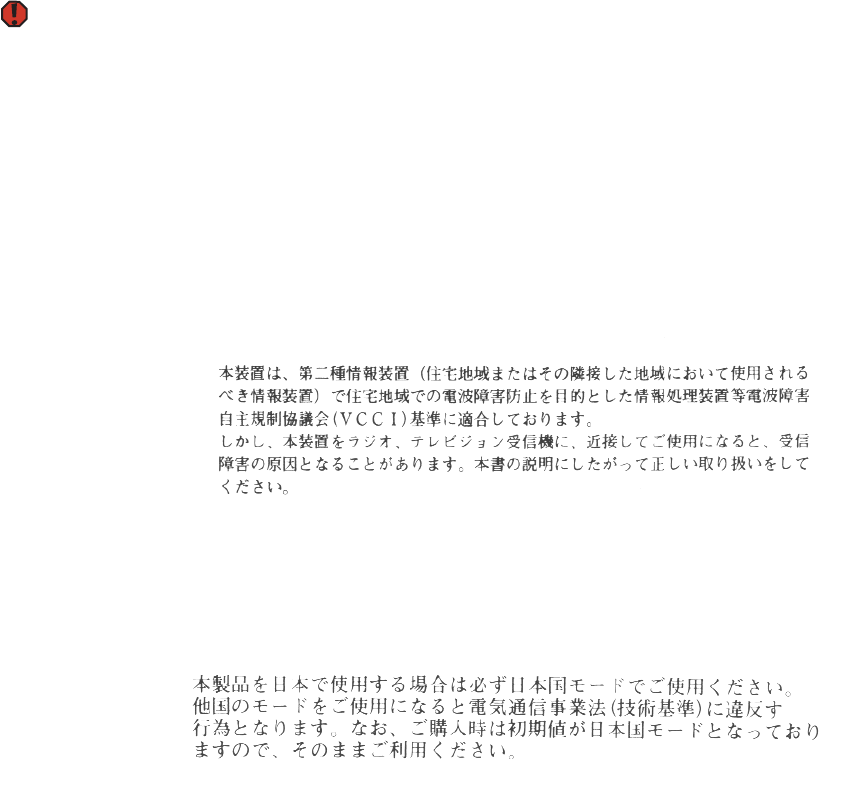
APPENDIX A: Safety, Regulatory, and Legal Information www.gateway.com
58
Telecommunications per Industry Canada CS-03 (for products fitted with an
IC-compliant modem)
The Industry Canada label identifies certified equipment. This certification
means that the equipment meets certain telecommunications network
protective, operation, and safety requirements. The Department does not
guarantee the equipment will operate to the users’ satisfaction.
Before installing this equipment, users should make sure that it is permissible
to be connected to the facilities of the local telecommunications company. The
equipment must also be installed using an acceptable method of connection.
In some cases, the inside wiring associated with a single-line individual service
may be extended by means of a certified connector assembly. The customer
should be aware that compliance with the above conditions may not prevent
degradation of service in some situations.
Repairs to certified equipment should be made by an authorized Canadian
maintenance facility designated by the supplier. Any repairs or alterations made
by the user to this equipment, or equipment malfunctions, may give the
telecommunications company cause to request the user to disconnect the
equipment.
Warning
To avoid electrical shock or equipment
malfunction do not attempt to make
electrical ground connections by yourself.
Contact the appropriate inspection
authority or an electrician, as
appropriate.
Users should make sure, for their own protection, that the electrical ground
connections of the power utility, telephone lines, and internal metallic water
pipe system, if present, are connected together. This precaution may be
particularly important in rural areas.
The Ringer Equivalence Number (REN) assigned to each terminal device
provides an indication of the maximum number of terminals allowed to be
connected to a telephone interface. The termination on an interface may consist
of any combination of devices subject only to the requirement that the sum of
the Ringer Equivalence Numbers of all the devices does not exceed 5.
Japan
Japanese Modem Notice

www.gateway.com
59
Laser safety statement
Warning
Use of controls or adjustments or
performance of procedures other than
those specified in this manual may result
in hazardous radiation exposure. To
prevent exposure to laser beams, do not
try to open the enclosure of a CD or DVD
drive.
All Gateway systems equipped with CD and DVD drives comply with the
appropriate safety standards, including IEC 825. The laser devices in these
components are classified as “Class 1 Laser Products” under a US Department
of Health and Human Services (DHHS) Radiation Performance Standard. Should
the unit ever need servicing, contact an authorized service location.
EPA ENERGY STAR
As an ENERGY STAR® Partner, Gateway has determined that this
product meets the ENERGY STAR guidelines for energy efficiency
when used with a computer equipped with a Display Power
Management System.
ENERGY STAR

APPENDIX A: Safety, Regulatory, and Legal Information www.gateway.com
60
Environmental information
The product you have purchased contains extracted natural resources that have
been used in the manufacturing process. This product may contain substances
known to be hazardous to the environment or to human health.
To prevent releases of harmful substances into the environment and to
maximize the use of our natural resources, Gateway provides the following
information on how you can responsibly recycle or reuse most of the materials
in your “end of life” product.
Waste Electrical and Electronic Equipment (commonly known as
WEEE) should never be disposed of in the municipal waste stream
(residential garbage collection). The “Crossed-Out Waste Bin” label
affixed to this product is your reminder to dispose of your “end of life”
product properly.
Substances such as glass, plastics, and certain chemical compounds are highly
recoverable, recyclable, and reusable. You can do your part for the environment
by following these simple steps:
■When your electrical or electronic equipment is no longer useful to you,
“take it back” to your local or regional waste collection administration for
recycling.
■In some cases, your “end of life” product may be “traded in” for credit
towards the purchase of new Gateway equipment. Call Gateway to see if
this program is available in your area.
■If you need further assistance in recycling, reusing, or trading in your “end
of life” product, you may contact us at the Customer Care number listed
in your product’s user guide and we will be glad to help you with your
effort.
Finally, we suggest that you practice other environmentally friendly actions by
understanding and using the energy-saving features of this product (where
applicable), recycling the inner and outer packaging (including shipping
containers) this product was delivered in, and by disposing of or recycling used
batteries properly.
With your help, we can reduce the amount of natural resources needed to
produce electrical and electronic equipment, minimize the use of landfills for
the disposal of “end of life” products, and generally improve our quality of life
by ensuring that potentially hazardous substances are not released into the
environment and are disposed of properly.

www.gateway.com
61
Notices
Copyright © 2006 Gateway, Inc.
All Rights Reserved
7565 Irvine Center Drive
Irvine, CA 92618 USA
All Rights Reserved
This publication is protected by copyright and all rights are reserved. No part
of it may be reproduced or transmitted by any means or in any form, without
prior consent in writing from Gateway.
The information in this manual has been carefully checked and is believed to
be accurate. However, changes are made periodically. These changes are
incorporated in newer publication editions. Gateway may improve and/or
change products described in this publication at any time. Due to continuing
system improvements, Gateway is not responsible for inaccurate information
which may appear in this manual. For the latest product updates, consult the
Gateway Web site at www.gateway.com. In no event will Gateway be liable for
direct, indirect, special, exemplary, incidental, or consequential damages
resulting from any defect or omission in this manual, even if advised of the
possibility of such damages.
In the interest of continued product development, Gateway reserves the right
to make improvements in this manual and the products it describes at any time,
without notices or obligation.
Trademark Acknowledgments
Gateway and the Black-and-White Spot Design are trademarks or registered
trademarks of Gateway, Inc. in the U.S. and other countries. SpotShop,
Spotshop.com, and Your:)Ware are trademarks of Gateway, Inc. Intel, Intel Inside
logo, and Pentium are registered trademarks and MMX is a trademark of Intel
Corporation. Microsoft, MS, MS-DOS, and Windows are trademarks or registered
trademarks of Microsoft Corporation. All other product names mentioned
herein are used for identification purposes only, and may be the trademarks or
registered trademarks of their respective companies.
Macrovision statement
If your notebook has a DVD drive and an analog TV Out port, the following
paragraph applies:
This product incorporates copyright protection technology that is protected by
U.S. patents and other intellectual property rights. Use of this copyright
protection technology must be authorized by Macrovision Corporation, and is
intended for home and other limited viewing uses only unless otherwise
authorized by Macrovision Corporation. Reverse engineering or disassembly is
prohibited.
APPENDIX A: Safety, Regulatory, and Legal Information www.gateway.com
62

63
A
AC adapter
connecting 11
connector 8
accessories
purchasing 33
safety precautions 53
application key 18
arrow keys 18
audio
adjusting volume 19, 23
back button 19, 20
headphone jack 6
microphone jack 6
muting 19, 20, 23
next button 19, 20
pause button 19, 20
play button 19, 20
stop button 19, 20
volume down button 19, 20
volume up button 19, 20
B
battery
bay 31
changing 31
charge indicator 6
charging 11
installing main 31
latch 9
locating 9
purchasing 33
recalibrating 32
recharging 11
release latch 9
replacing 31
bays
battery 31
hard drive 9
memory 9, 36
Bluetooth 19
brightness
adjusting 19
system keys 19
C
cable lock 8
cable modem 8, 13
camera
See digital camera
See digital video camera
Caps Lock indicator 16
cards
Express Card slot 7
inserting Express Card 27
inserting memory card 25
memory card slot 6
memory cards supported 25
removing Express Card 27
removing memory card 25
slots 25, 27
carrying case 33
CD
inserting 25
CD drive
See DVD drive
cellular phone
memory cards 25
Certificate of Authenticity 3
clicking 22
closing unresponsive program 15
connecting
AC adapter 11
dial-up modem 12
external keyboard 17
external monitor 28
keyboard 17
printer 28
projector 28
scanner 28
television 30
to cable modem 13
to DSL modem 13
to Ethernet 13
to network 13
video camera 31
connections
audio 6
broadband Internet 8, 13
cable modem 8, 13
dial-up modem 8, 12
digital camera 7, 8
digital video camera 7, 28
DSL modem 8, 13
Ethernet 8, 13
external audio 6
external diskette drive 7, 8
external speakers 6
Firewire 7, 28
flash drive 7, 8
headphone 6
i.Link 7, 28
IEEE 1394 7, 28
keyboard 7, 8
microphone 6
modem (dial-up) 8, 12
monitor (VGA) 8, 28
mouse 7, 8
network 8, 13
power 8, 11
printer 7, 8
projector 28
scanner 7, 8
speaker 6
S-Video (TV) out 8
S-Video out 30
television 30
USB 7, 8, 28
VGA 8, 28
video camera 7
copyright notice 61
CyberLink PowerCinema 14
D
dial-up modem 8, 12
digital camera
memory card reader 6, 25
USB port 7, 8
digital video camera
connecting 31
IEEE 1394 port 7
directional keys 18
display
properties 28
switching 18
double-clicking 22
dragging 22
drives
CD 24, 40
DVD 24, 40
DVD/CD-RW 7, 24, 40
DVD±RW 7, 24, 40
hard drive 9, 42
identifying drive types 24
multi-format DVD±RW 7, 24, 40
replacing hard drive 42
types 24
DSL modem 8, 13
DVD
inserting 25
playing 30
DVD drive
identifying 24
installing 40
locating 7
replacing 40
using 24
DVD/CD-RW drive
See DVD drive
DVD±RW drive
Index
Index www.gateway.com
64
See DVD drive
E
electrostatic discharge (ESD) 36
Ethernet
connecting 13
jack 8, 13
Express Card
adding 27
inserting 27
installing 27
removing 27
slot 27
external monitor 8, 18
EZ Pad touchpad
See touchpad
F
fan 7, 8
files
opening 22
Firewire port 7, 28
Fn key 18
folders
opening 22
function keys 17
G
Gateway
model number 2
serial number 2
Support 3
H
hard drive
bay 9
indicator 16
installing 42
replacing 42
headphone jack 6
hot-swapping 27, 28
I
i.Link port 7, 28
IEEE 1394 port 7, 28
indicators
See status indicators
inkjet printer 33
installing
battery 31
devices 28
digital camera 28
digital video camera 28
DVD drive 40
Express Card 27
hard drive 42
memory 36
peripheral devices 28
printer 28
scanner 28
J
jacks
See connections
K
Kensington cable lock
lock slot 8
key combinations 18
keyboard
buttons 17
connecting 17
features 17
locating 10
USB port 7, 8
keys
application 18
arrow 18
battery status 18
brightness 19
directional 18
Fn 18
function 17
LCD brightness 19
LCD/CRT 18
navigation 17
numeric keypad 18
power status 18
Standby 18
Status 18
system 17
system key combinations 18
toggle display 18
Windows 18
L
labels
Microsoft Certificate of
Authenticity 3
model number 2
serial number 2
laser printer 33
latch
battery 9
LCD panel release 6
LCD panel
release latch 6
switching display 18
LCD/CRT system key 18
Live Launch
button 10, 14
lock
Kensington cable 8
M
memory
bay 9
installing 36
purchasing 33
removing 36
replacing 36
memory card reader
locating 6
memory cards supported 25
using 25
microphone
jack 6
Microsoft Certificate of
Authenticity 3
model number 2
modem
cable 8, 13
connecting 12, 13
DSL 8, 13
jack (dial-up) 8, 12
monitor
adding external 28
color quality 29
display properties 28
port 8
screen resolution 29
using 18
mouse
USB port 7, 8
moving
pointer 22
screen objects 22
MP3 player
memory cards 25
multi-function buttons 10, 20
multimedia
adjusting volume 23
using DVD drive 24
muting sound 19, 20, 23
N
navigation keys 17
network jack 8, 13
networking
turning off wireless network 23
turning on wireless network 23
NTSC/PAL jack 30
Num Lock
status indicator 16
system key 18
numeric keypad
status indicator 16
Index
www.gateway.com
65
using 18
O
opening
files 22
folders 22
LCD panel 6
notebook 6
programs 22
shortcut menu 22
P
PCMCIA card
See Express Card
PDA
memory cards 25
peripheral devices 28
Plug and Play devices
IEEE 1394 support for 28
USB support for 28
pointer
identifying 21
moving 22
power
AC adapter 11
battery 31, 32
button 10, 18
connector 8, 11
indicator 6, 14
source problems 12
Standby mode 14, 18
status box 18
status indicator 6
turning off notebook 15
turning on notebook 14
printer
inkjet 33
installing 28
laser 33
USB port 7, 8
programs
closing unresponsive 15
opening 22
projector
adding 28
color quality 29
display properties 28
port 8
screen resolution 29
using 18
R
RAM
See memory
rebooting notebook 15
recalibrating battery 32
replacing
See installing
resetting notebook 15
restarting notebook 15
right-clicking 22
S
safety
general precautions 52
static electricity 36
scanner
installing 28
USB port 7, 8
screen
resolution 29
screen objects
getting information 22
moving 22
selecting 22
scroll zone 21
security features
Kensington cable lock 8
serial number 2
setting up
safety precautions 52
shortcut menus
accessing 22
shortcuts
opening menu 22
shutting down notebook 15
SO-DIMM
See memory
sound
adjusting 19, 20, 23
controls 20, 23
muting 19, 20, 23
speakers
built-in 6
jack 6
Standby
mode 14, 18
system key 18
starting
notebook 14
programs 22
static electricity 36
status indicators
battery charge 6
Caps Lock 16
drive activity 16
hard drive 16
location 10
numeric keypad 16
Pad Lock 16
power 6
toggle on or off 18
surge protector 12
Suspend 18
S-Video (TV) out
jack 30
S-Video (TV) out jack 8
system identification label 2
system keys
combinations 18
locating 17
T
technical support
Support 3
television
playing DVD on 30
TV out jack 30
viewing display on 30
television (S-Video out) jack 8
touchpad
buttons 21
clicking 22
double-clicking 22
dragging screen objects 22
locating 10
moving pointer 21, 22
moving screen objects 22
opening files, folders, and
programs 22
opening shortcut menu 22
right-clicking 22
scroll zone 21
selecting screen objects 22
turning off
notebook 15
wireless network 18, 23
turning on
notebook 14
wireless network 18, 23
TV out (S-Video out) jack 8
U
upgrading 35
USB port 7, 8, 28
V
VGA port 8, 28
video
monitor port 8
projector port 8
S-Video out jack 8
VGA port 8
video camera
connecting 31
volume
Index www.gateway.com
66
adjusting 19, 23
controls 20, 23
muting 19, 20, 23
system keys 19
W
waking up notebook 14
Windows
key 18
Product Key Code 3
wireless network
button 18
turning off 23
turning on 23

MAN
BANSHEE
HW
REF
R0
7/06